Forum Replies Created
-
AuthorPosts
-
Very nice Marcel!!


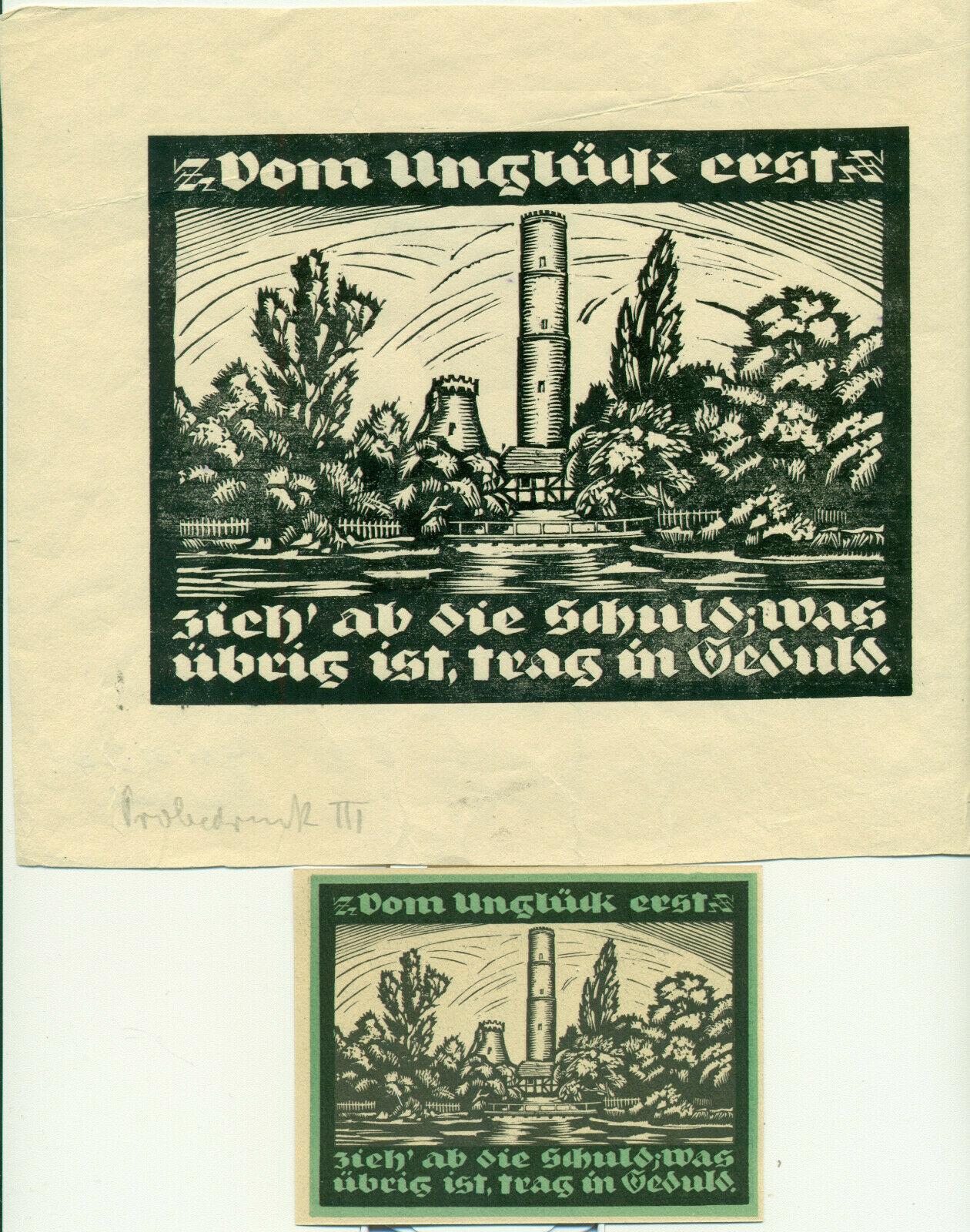

Original Probedruck by Alfred Hanf.
My latest asset and a mastercatch. I am very proud to have this piece in my collection.
It is the back side of the note of the place Genthin, serie Ortsbilder 1 Mk in black and white.
The inside measures are 12,5 x 17 cm and the outsite are 19 x 23 cm. On the front is written in pencil: “Probedruck III†and on the rear also in pencil: “Reg.nr: 51 II a†and signed by the master Alfred Hanf.
Alfred Hanf is also the artist of Serienscheine for the places Erfurt, Sömmerda, Gebesee and Weissensee.
Hanf was a graphic artist, painter and book illustrator, who lived his whole life in Erfurt ( 1890 – 1974).
There are some great new items available in the shop now, so please have a look whilst they remain available. They could be ‘one-off’ chances for you to acquire such pieces? I can lay-away notes from members if that helps – please don’t lose the opportunity…………..
Anyone had any interesting additions to their collections lately?

I’ve just had a few more ‘pig’ notgeld pointed out to me, so I have added those to the ‘piggies’ article.
If anyone spots an article where an update or amendment is required, please let me know.

The central design of the banknote’s background design has to be like the note depicted – a shield like emblem with the 3 words
GIROVERBAND
SACHSISCHER
GEMEINDEN
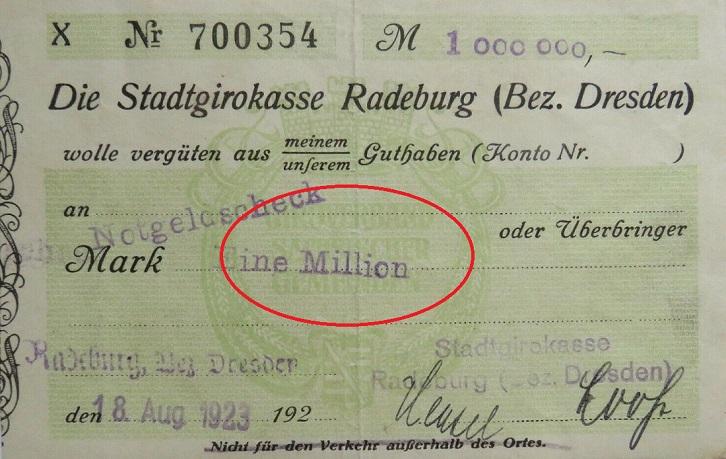
Thanks…..

Hopefully some of you will have seen one of my latest articles on the ‘GSG’ (GIROVERBAND SACHSISCHER GEMEINDEN) giro cheque banknotes. I am now looking for scans of pieces that anyone actually has in their own collections please – not pieces on eBay or other internet sites, but ones that you own yourself only please. (someone is checking through series and numbers and face values etc) If you have a piece that is not from a place on this list, I would be really very interested to see that!
The banknote should look extremely similar to this example from Erfenschlag:
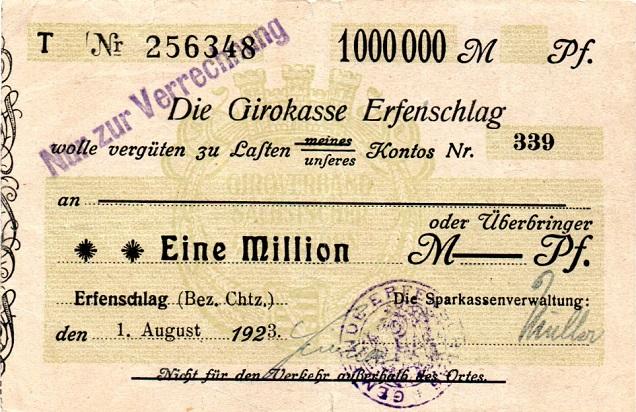
- Altenberg
- Auerbach
- Baerenstein
- Boehlitz-Ehrenberg
- Borna
- Bretnig
- Brand-Erbisdorf
- Burgstädt
- Copitz)
- Dresden (Girozentrale)
- Ebersbach
- Erfenschlag
- Elster, Bad
- Elsterberg
- Geising
- Geringswalde
- Gersdorf
- Geyer
- Glashuette
- Goeppersdorf
- Grimma
- Groitzsch
- Grossenhain
- Grossroehrsdorf
- Grossschoenau
- Hartmannsdorf
- Hartha
- Herold
- Herrnhut
- Hohenfichte
- Hormersdorf
- Jahnsbach
- Krumhermersdorf
- Langenau
- Lausigk, Bad
- Lengenfeld
- Leutersdorf
- Limbach
- Marienberg
- Markersdorf
- Markneukirchen
- Meissen
- Mittweida
- Muehlau
- Netzschkau
- Neukirch
- Neukirchen
- Niederlungwitz
- Niederneukirch
- Niederseiffenbach
- Oberneukirch
- Oberstuetzengruen
- Oberwuerschnitz
- Oederan
- Oelsnitz
- Ostritz
- Pegau
- Penig
- Pockau
- Radeburg
- Reichenau
- Rochlitz
- Roetha
- Sebnitz
- Seifhennersdorf
- Siegmar
- Waldkirchen – (see next)
- Waldkirchen-Zschopenthal
- Waltersdorf
- Wehrsdorf
- Weinboehla
- Wiesa
- Zoeblitz
- Zschopau
- Zschopenthal – (see Waldkirchen)
- Zwenkau
Hi Zacary!
Hope you are well – nothing springs to mind at the moment………but I might flick through the catalogues………..

It comes to me – Vohwinkel I think?
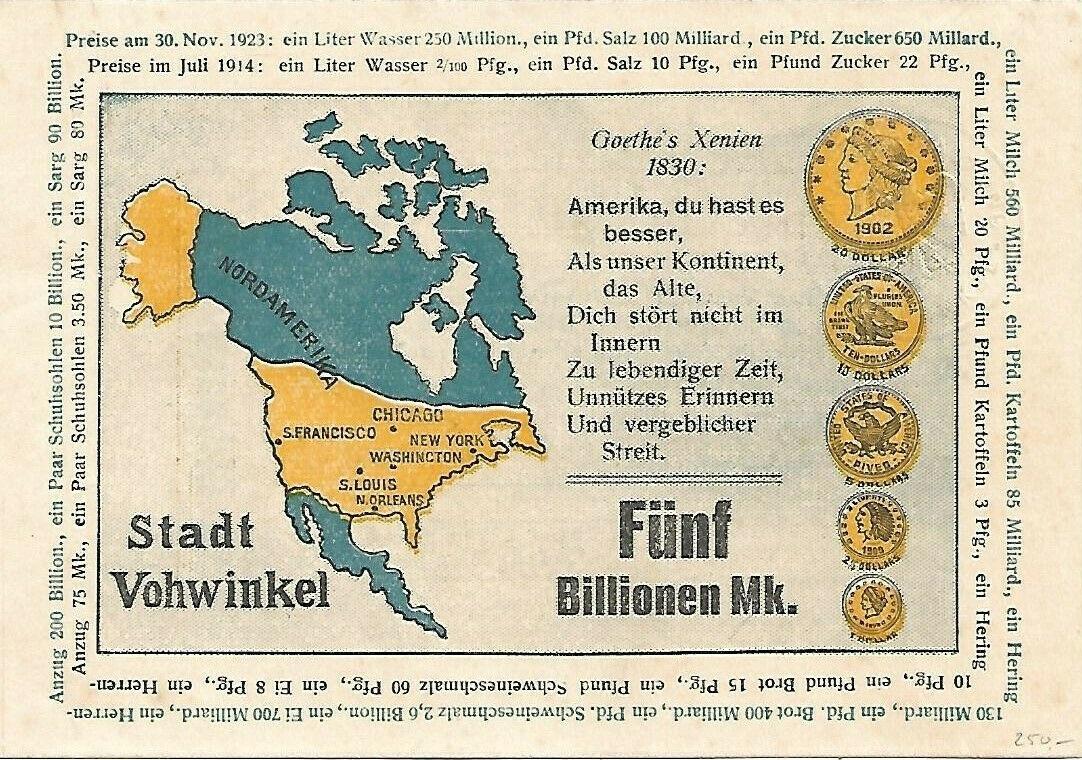
Hey everyone. I am trying to remember a notgeld I am pretty sure I once saw, but can no longer remember, nor can I find again online.
I believe the main design on the front was a map, but coming out from the top-right corner across the map was a parade of coins (I thought they were US coins, but I could be forgetting). I remember it was on the rarer side of things, as I know I couldn’t afford it when I saw it.
Any thoughts?
Hi Marcel!
Its all interest stuff that makes collecting notgeld such a great hobby. Most of these differences are catalogued as they are known about. At this time (1921) towns issuing serienscheine were only really after jumping on the band wagon, so to speak, to make money from the collectors.
An article would be interesting for a lot of people I think. I have several of these ‘differences’ already covered so I will see what is what and the best way forward – maybe for now a basic list so we don’t lose the info. Articles like your post info and picture could then be created. These small and sometimes unseen differences by the majority of people, are what made me specialize in serienscheine notgeld issues in the beginning.
I’ve just re-written a couple of articles : an Austrian piece issued on reused wallpaper and a German note issued on reused card (a milk card).
What a super hobby we have !!



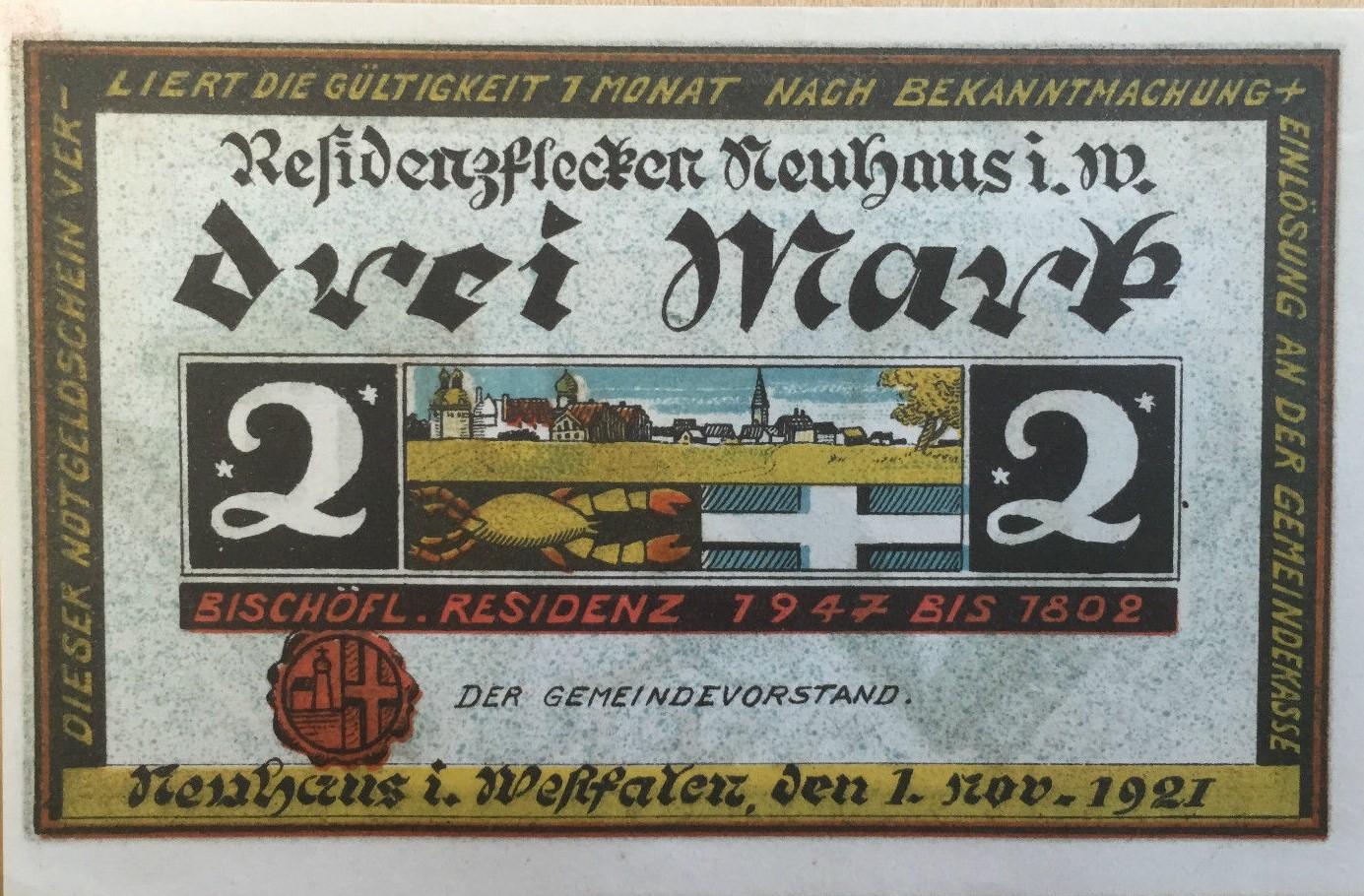
My latest asset: Neuhaus (Westfalen). At first sight a normal note, but when you are looking closer you see two remarkable things.
1. It is a 2 Mark note, but in letters you see 3 Mark (“Dreiâ€). The printer made a mistake and used the wrong print plate. The fronts of the 1, 2 and Mark notes are the same.
2. The inscription below the picture says: 1947 – 1802. The normal inscription is 1247 – 1802, but the print plate was wearn down and the “2†became a “9â€.
But all this is curious. Why issue these printing mistakes? You may think that it was overlooked, but when you see the price (E 3,– and the depicted note 30,–), there where lots of them. Had Neuhaus no money to make a new printing plate? An other possibility is that the printing sheets with the mistakes where issued on a later time as a curiosity.
I do not believe this all. The naughty thought I have is that Neuhaus was not really interested in the notes itself, but they where only in for the money.
There are more notes with printing errors: Auenbüll (Eiech instead of Eiche (“oakâ€)), Paulinzella (the expiration date), Atenwerder (corrections in the name of the Druckfirma (printing company), Warin the number B3 on yellow base instead of red for example.
#Tony: May be a nice article with mistakes on Serienscheine.
A collector colleague is after a picture of a German notgeld piece from Gießübel (Thuringia). This isn’t the Austrian Giesshuebel notes.
Apparently it sold on eBay but I can’t find it. Does anyone have a picture of the note they can send me please, so I can pass it on? The collector thinks its a Paycheck or a printed place order on the bank for Thuringia, probably Meiningen branch…….

Here are a couple of notgeld that have landed on my desk. Issued in Stollberg, the notes have different signatures.
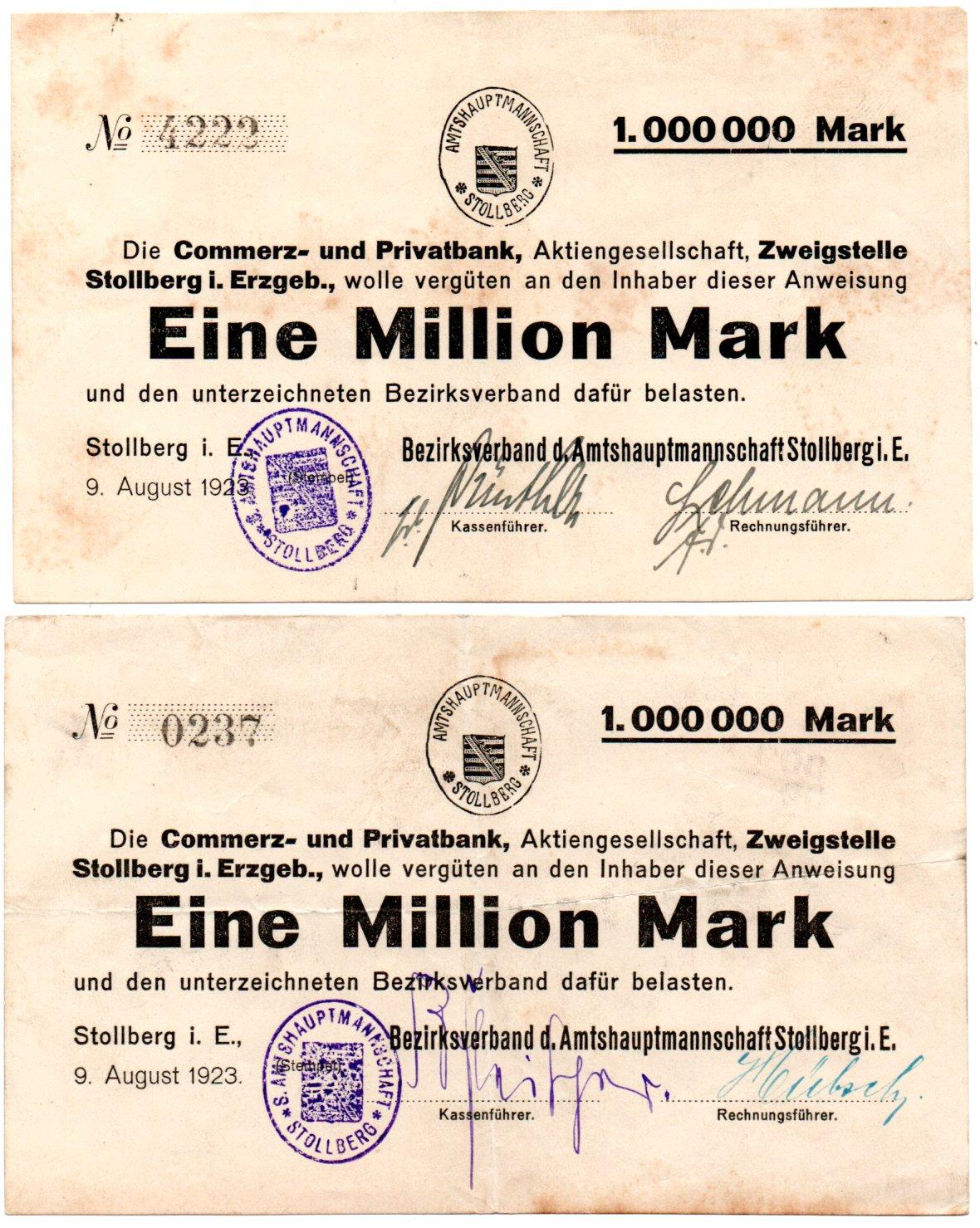
Can anyone help me please? Does anyone own or know of German notgeld banknotes with a fingerprint signature? (sign of official authority). I now have notes from these different places:
- Aurich
- Hasslinghausen
- Mohrungen
- Olpe
but there are probably others?? Thanks in advance

I’ll add the pictures to the ‘Willi Lippert’ article if you can send them to me direct please? So they are catalogued now as Baustein but serienscheine too?
I don’t need them in my new book as that only covered ones ‘known’ by Grabowski. The PUZ is the most up to date catalogue for serienscheine you can get so will hopefully become much more available after the planned update you spoke to me about…..whenever that is planned for.
Where did you get them from – absolutely fascinating!!

Hallo John,
Thanks you for your elaborate explanation of the notes (missed the book), the biography of Lippert and the compliment.
Much is now more clear. I am reading a book about the history of Germany. In this book is a chapter about the preoccupation of the 19th century Germans with the middle ages (and later on the NS period). The so-called “invention of the middle ages” . In the Serienscheine you see a lot of history; the feasts around the founding of cities, the landscape, fairy-tails, woods, citywalls and gates, castles and churches et cetera. I think it is a way to create a common history for all Germany. The land was ages shattered in hunderds of states, all with their own history. Just in 1870-1871 Germany was forced to be one country. The “new” Kaiserreich (second Reich) was seen as a kind of continuation to the Kaisers Otto’s and Frederik’s period (first Reich, 10-12 century).
Yes, I could either not find anything about a Jugendheim.
Wow Marcel these are truly beautiful notes!
The artist W.H. Lippert’s biography might be informative about the medieval setting of the pictures. Willi Otto Lippert (1898-1981) was a local of Rathenow and a keen member of the Wandervogel organisation (1896-1933), which rejected industrialisation and communed with nature by hiking and camping; they were also folksy nationalists and a major feature of their gatherings and hikes was the singing of folk songs. Karl Fischer, the successor of the movement’s founder Hermann Hoffmann, saw the Wandervögel as latter-day medieval travelling scholars, and indeed under his leadership members were referred to as Scholaren.
It’s probably no surprise that Willi Lippert had a medieval nickname within the group, Horsa (after the Saxon chieftain who began the post-Roman conquest of Britannia);Â he liked the name so much that he changed his name to Willi Horsa Lippert, hence the signature “W.H. Lippert” rather than “W.O. Lippert”.
With this in mind, we can perhaps read the iconography of the notes as follows :
2 Mark : two young men, medieval wandering minstrels (one with his hair in a floral wreath familiar in depictions of the Wartburg Minnesänger contest in 1207, the other wearing a band to keep his flowing locks in place), arrive near Rathenow but can find no room at the inn. The face of the man on the right is visibly in shadow and with a downcast expression.
5 Mark : A thoughtful young man, resting from lute practice and with a book clutched to his breast, has the idea of building a wayside hostelry for weary travellers, especially travelling scholars and free spirits such as himself. Perhaps the blueprint of a building, tacked to the wall, has inspired him.
10 Mark : local artisans build a such a place.
The series thus incorporates the ideals and the self-image of Lippert’s Wandervogel background, appropriately in raising funds for the building of a youth hostel.
Lippert had joined the Kaiser’s forces at the age of only 16, volunteered as a radio operator in the new submarines and survived the war to take up again his association with the Wandervogel movement and begin his career as an artist. He designed Notgeld – Serienscheine and inflationary issues – for Rathenow and a number of other issuing towns in the March of Brandenburg, Silesia and Pomerania. At the beginning of the National Socialist regime, the Wandervogel movement was banned and Lippert was arrested and sent to the Oranienburg concentration camp, where he was apparently required to design their Lagergeld.
Sadly, it seems that the Youth Hostel in Rathenow was never built, most likely because the rampant inflation reduced the sums collected to meaningless amounts.
Rathenow, Jugendheim 10 Mark rear wth a unidentified stamp. Not known in Grabowski and Lindman/PUZ.
The 10 Mark note is also known with three overprints: 25 Mark, 50 Mark and 100 Mark.
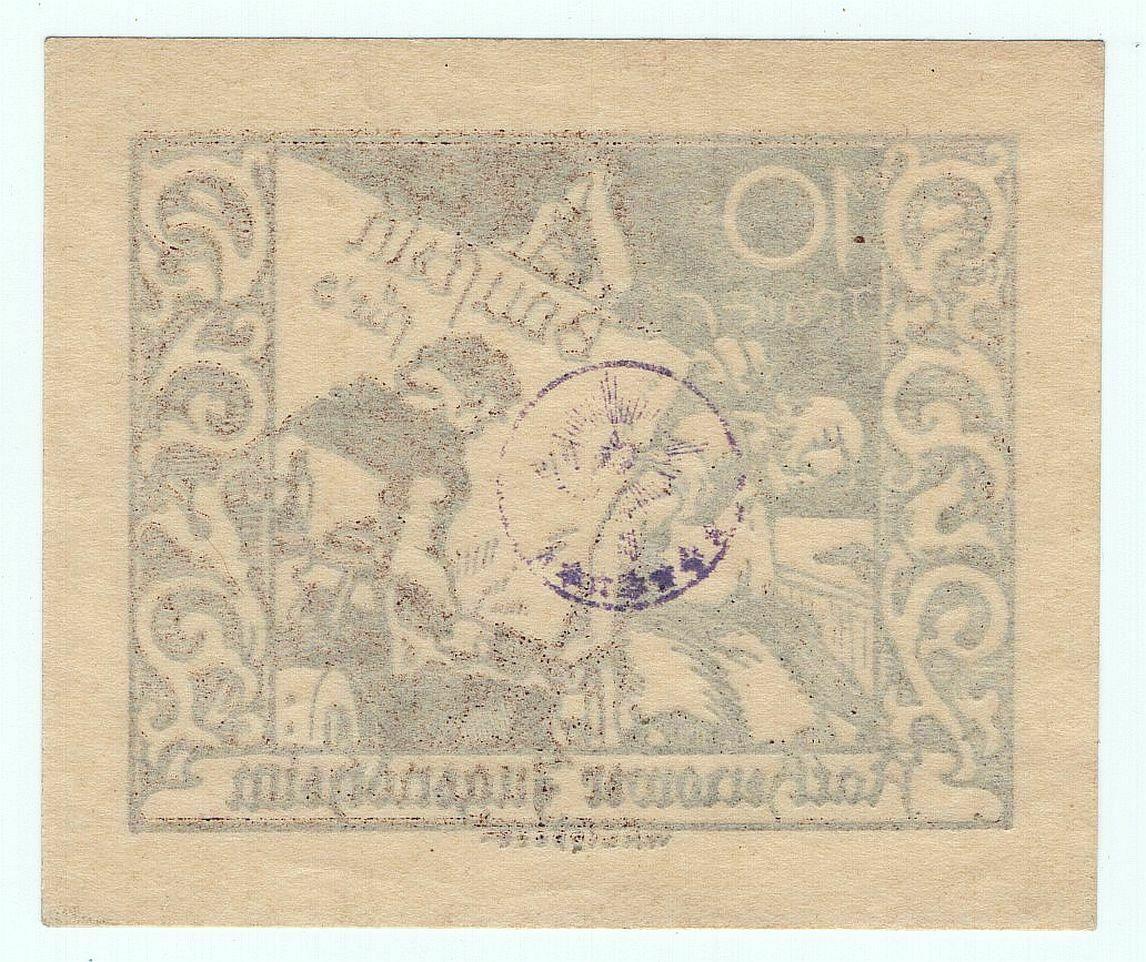
Rathenow: Rathenower Jugendheim  2 Mark, 10 Mark and 5 Mark. The rear of the notes are empty. (Lindman/PUZ 1068.1   Gr. 1098.1). These three notes are in my collection. They are “Bausteine” for a “Jugendheim”: building blocks for a youth home. The pictures are from the artist W. H. Lippert. The 2 Mark note is a romantic picture of a couple (on horseback?) who fell in love with there (new) home. On the 5 Mark note you see a young man sitting in a big chair next to a workbench. On the bench are paperrolls (floorplans?) and on the wall you see a drawing of a floorplan of a house (the Jugendheim?). Between his legs he has a lute. The young man is in deep thoughts (See the decoration on both sides: a growing plant as a metaphor for the building of the new Jugendheim). The 10 Mark shows three men who are actually making a Baustein for the Jugendheim.
I do not have a picture of the 1 Mark.
Why are the pictures in a medieval setting? A Jugendheim as a castle, as in “my home is my castle”?
m

Hi chaps!
I have the sets on eBay covered – thanks.
Marcel – can you email me pls with your sets’ details…..including serial numbers.
Originally I thought there might have been 2 different runs, one for the same number sets and another for the consecurive numbered pieces. Thinking more about how this happened leads one to even more questions. My understanding is : the notes were printed and cut up……and then put through the numerators. If there were 6 numerators at this print shop, then all the pile of ‘note1’ could be loaded into the first numerator…….all the pile of ‘note2 could be loaded into the second numerator etc. So the first note out of each of the 6 numerators would be ‘1’………the second note from all the numerators would be numbered ‘2’ and so on………ok -so there we have the same serial numbered sets. To chnage and get consecutive numbered sets, one would have to remove a note from the 2nd pile, 2 notes from the 3rd pile, 3 notes from the 4th pile etc…….removing a total of 15 notes in total. Then one could collect the notes out of the numerators 1 – 6…….2 – 7………3 – 8. But I think they could have just stacked the blank sets into 1 numerator and then started numbering…………1-6…….7-12…….12-18 etc…..
But I don’t know why anyone would do it. It would be easier to keep all the same serials together and maybe sell those sets with a premium as they all have the same number. maybe a collector would want a consecutive numbered set awell……..so could be a good ploy to sell more pieces overall?

Hallo Nate and Tony,
What a beautiful set is Bückeburg. A very nice buy! And also NOT in the PUZ catalogue. The transformation from black to color is fine. Even the serial number in on the 1,50 Mark is black and on the other two are red. May be they were a gift or example pieces from the printer or the school.
(And, notes without serial numbers are more “common” than with, because you have to print them in an extra run)
Schmalkalden, Serie 1 with KN 3 mm: https://www.ebay.de/itm/363479732561?hash=item54a1149151:g:VvkAAOSwZ4Vg–dL    And I have in my collection Serie 3 with KN 4,5 mm. I have consecutive numbers Serie 1 KN 4,5 mm and Serie 3 KN 3 mm.
A few years ago I stayed a few days in Schmalkalden. A nice town. I saw the Iwan-pictures (just the replica’s) and the buildings on the Serienscheine. On a wall there were the pictures of the leaders of the Schmalkaldischen Bund. The Serienscheine depicts the history and about after 100 years still the reality.
Tony – Don’t think I have one of the Schmalkalden sets myself, but I did find a set with consecutive serials on eBay: https://www.ebay.com/itm/363479734138?ssPageName=STRK%3AMEBIDX%3AIT&_trksid=p2060353.m1438.l2649
Hi Nate!
Looks like they aren’t catalogued – no serial and no stamp. They could be ‘left over’ pieces that were never used/issued that someone found……..but that doesn’t really make any sense with serienscheine does it??
 The 3 pieces that I had and sold all had serials.
The 3 pieces that I had and sold all had serials.Schmalkalden – I can’t believe that no one has got a set to report in?

The article is under serienscheine/series general/serial numbers………

Also, I don’t believe this particular variant (No stamp + No serial number) is listed in the catalogs? Can anyone help me confirm or help ID? Thank you!
Picked up a new set from Bückeburg recently that I’ve been wanting to find for a long while. Prior to obtaining them, I hadn’t seen any clear images of the 3 notes together, so I didn’t fully realize the design differences and how they progress from black and white to full color as the denominations increase, which I thought was really cool. Here are some scans:
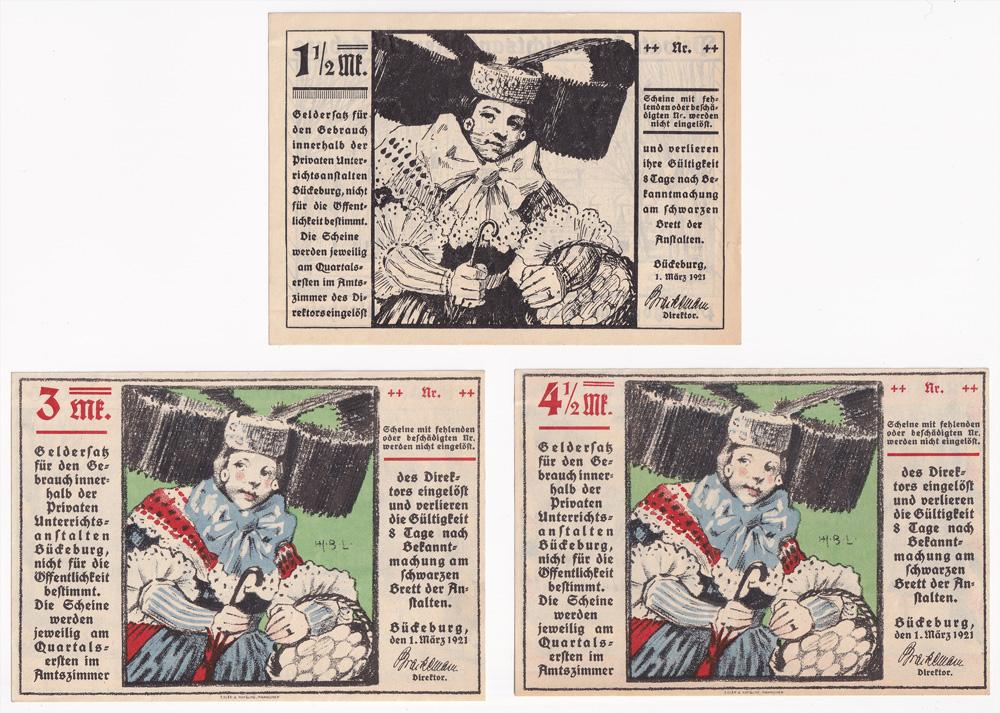
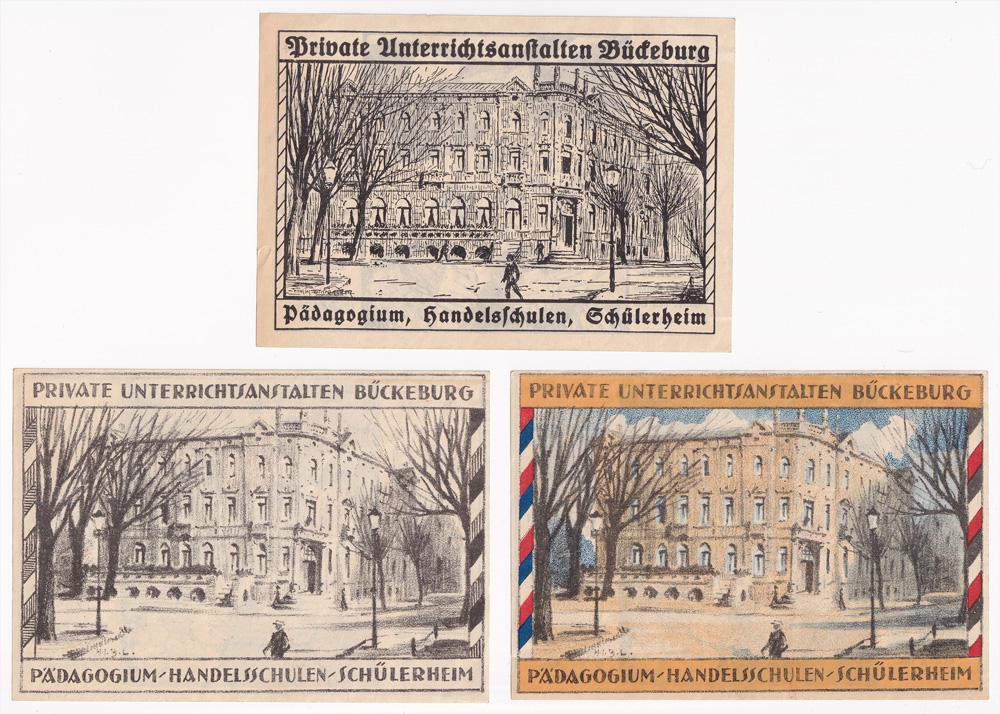
If anyone has a ‘true’ complete set of any of the 3 sets of 6 pieces from Schmalkalden (that is all 6 serial numbers are the same OR the 6 serial numbers are consecutive), could they please let me know and email me across a picture please? Thanks in advance! I am working on a query at the moment but I need a bit more data……..


Rehburg (set of 8) now added to the listing of Franz Juettner!
Hi to all of you – I have just found out some interesting info which is now included in my ‘1914 & 1915 Intro’ article, which you can find under ‘categories’ on the main yellow menu bar. The new info is right at the top of the article – the Bremen Burgliches Brauhaus
Hope you enjoy it as much as I did fnding it!

Marcel has mentioned a few others, documented in ‘Papiergeld#18’, so I have added those to the bottom of my ‘Wilhelm Busch’ article…..but only as ‘possible’. I was looking through some pieces and the Neustadt piece, with the hand punching through the paper, definitely looks like WB to me. I don’t know if that was the one that was referenced before. It is such a shame, as Marcel says, that so many of these notgeld graphics are not signed or initialed by the artist.
Happy collecting!
I’ve also just published the latest article about the graphics on the Bielefeld 10,000m linen pieces – Thanks John!!

I’ve started to write an article on Wilhelm Busch – so far I have notgeld from Bockenem, Gatersleben, Stolzenau & Wiedensahl. Has anyone got anymore for me please??

Hi Gary!
Yes, indeed this is one of the pair of serienscheine notes (25 + 50pf) issued and cataloguing under ‘Bucha’.
There are only a few pieces I think where collectors will always have difficulty like this. The Bad Zwischenahr ‘Ammerland’ note is another that springs to mind.
I am sure there are people on this forum that will be able to identify a place of issue for anyone who is having trouble. I can’t answer your query about how you would work out from the design and wording that the note you show is from Bucha though, unless you are told……..
This is why YOU are the real forum guru!! Fantastico!!

Hi Tony, August Teichmann was a textiles manufacturer. The firm is named in a 1922 court case in archived material of the Free State of Saxony, seeking damages for cotton offcuts lost in a fire on the railways. It didn’t survive this awful economic year, when it was also issuing its Notgeld; the Saxon archive also lists the years in which the firm was active as 1912-1922, in a separate section of the archive naming defunct firms – here it is referred to as Webwarenfabrik von August Teichmann, Wingendorf (Woven Goods Factory).
Hello all, here I am with a puzzle again. Still sorting collections of Notgeld that I purchased and came across the one in the picture. It came with a 50 pf with the identical design.
I finally managed to track down where it’s from, but I’d love to hear from anyone as to how to go about this procedure.
I checked under POSENMILL, under the name of the famous man pictured, but no luck. What else to do? I checked Ebay searching under POSENMILL and found this being sold along with the name BUCHA.
Aside from spending 2 weeks with in-laws that I haven’t seen for 2 years, this is why it takes me so long to sort and put my notgeld into albums.
Almost finished, another week should do it.
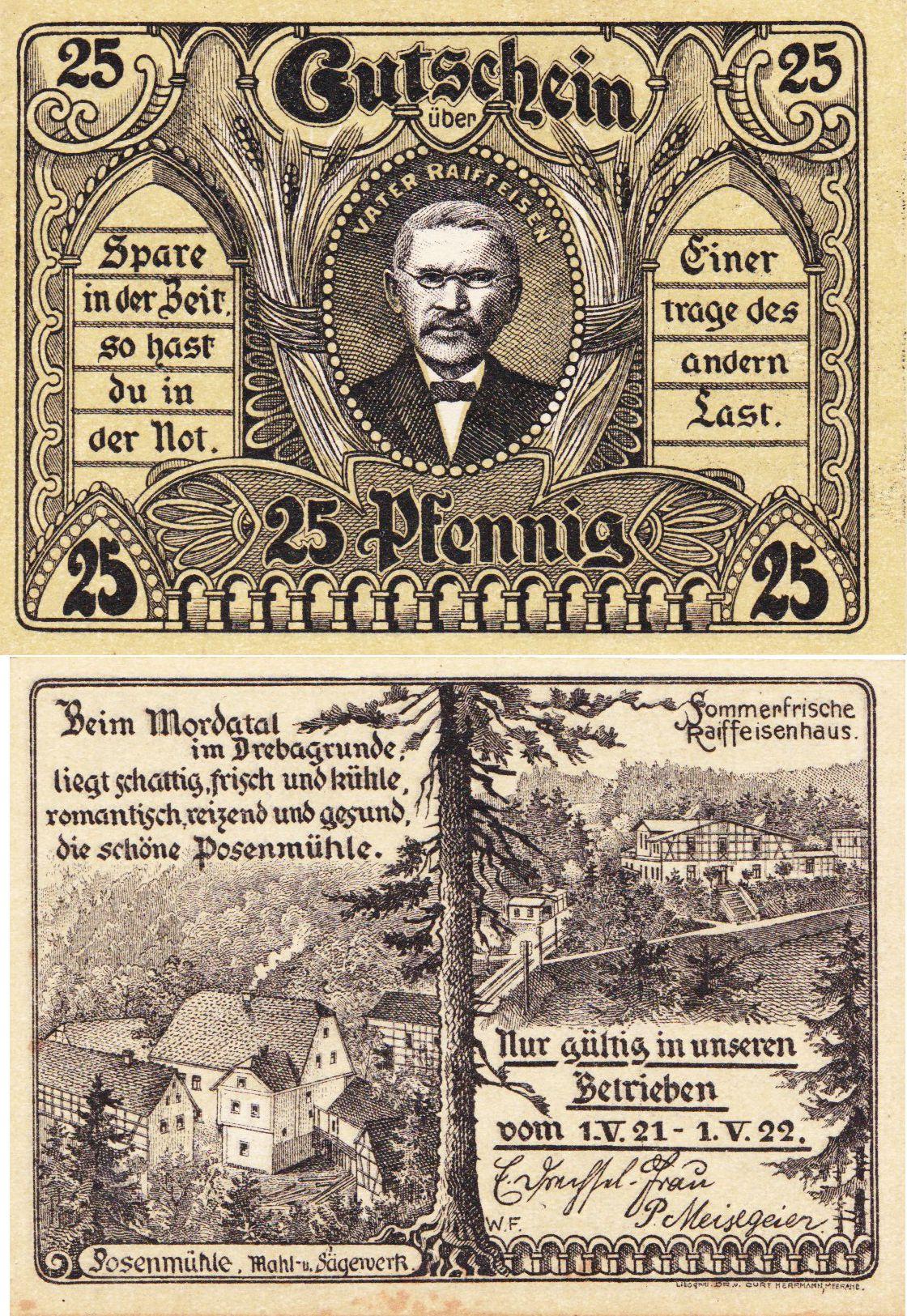
Can anyone answer this question for me please? : The 1922 Wingendorf notes issued by ‘August Teichmann’………what business was he in or what did Mr. Teichmann do?
Thanks in advance…..
I will be asking other notgeld contacts I have too in the meantime. Once I have an answer, hopefully………I will update the Wingendorf article (under specific towns, under Inflation 1922)

….and now the ‘C’ ones too – good work Nate.
What do other collectors think of what Nate is doing here? Please have a look at his work/project…….
Thanks, Tony!
I just updated the catalog – all “B” issuing localities are live! Check it out :)
There is a link to Nate’s catalogue that can be accessed from the main yellow menu bar on the homepage. Hopefully that makes it more easy for people.
Select categories/serienscheine and then ‘Nate’s serienscheine catalogue’. As the catalogue pages increase, I think this will be a wonderful help, especially to to new collectors – well done Nate.

As some of you know, I’ve been working on a notgeld catalog. The first section is now live: http://notgeldwiki.com/series-notgeld-catalog
This first update includes all the “A” issuing localities. I’ll be adding updates in alphabetical order, so the next “B” update will be live soon.
As some of you know, I’ve been working on a notgeld catalog. The first section is now live: http://notgeldwiki.com/series-notgeld-catalog
This first update includes all the “A” issuing localities. I’ll be adding updates in alphabetical order, so the next “B” update will be live soon.
Nate – I have just updated my ‘coal coins’ article with some of the info recorded in the Fraktur literature.
There seems to be an error in the listing of the serial numbers as 500m is mentioned twice and not a 1000m. Hopefully that was just a typo mistake …..but we can’t assume anything here. I have added the numbers to my article but for now, have not included them in my table.
Does anyone have any of these pieces in their collections that I have not recorded in the table? I’m looking for face value of coin, diameter, thickness and serial number inscribed on the coin(s) – thanks in advance!
I thought I had posted before but might have forgot to submit !- thanks guys for all the wonderful info and pictures. You are keeping me busy and I hope everyone is finding it all fascinating stuff.
I just read about Kai Lindman’s passing and would like to add my condolences to his friends, family and all the collectors who have been influenced by him or his writings.
While researching Notgeld motifs, especially those featuring townscapes and buildings long since bombed into rubble, I often have recourse to historical postcards. Recently I was delighted to come across a card, postmarked Halberstadt in 1907, featuring a picture which clearly served as the source for one of the designs depicting a sabbat on the Hexentanzplatz, the Witches’ Dance Floor, a mountain plateau above the town of Thale, a prolific issuer of emergency money.  The design is on six variant 25 Pfennig notes of the series G.M. 1320.4 (red, “Walpurgis 1921â€), 1320.5 (green, “Walpurgis†– shown here), 1320.6 (green, “Walpurgis 1922â€), 1320.7 (red, no start date), 1320.9 (orange, “Johanni 1921â€) and 1320.22 (grey-blue, “Sylvester 1921â€).
The pseudo-armorial shields, added by the Notgeld designer of 1921, depict the witches’ modes of transport mentioned by Goethe in Scene 21 of his drama Faust Part One (where he has the sabbat taking place not on the Hexentanzplatz but the nearby Brocken Mountain), namely broomsticks, a stick and a pitchfork  : “Es trägt der Besen, trägt der Stock, die Gabel trägt ….â€.
A note on the dates : Walpurgis is 1st May (St Walburga’s Day), Johanni is 24th June (Feast Day of the Nativity of St John the Baptist) and Sylvester is 31st December (St Sylvester’s Day).
Here is an interesting scan from the May 1995 issue of The Fraktur regarding the coal notgeld pieces. I was unaware of these lead patterns previously.
I recently digitized the entire 12.5 year run of The Fraktur, which you can find here -> notgeld.wiki
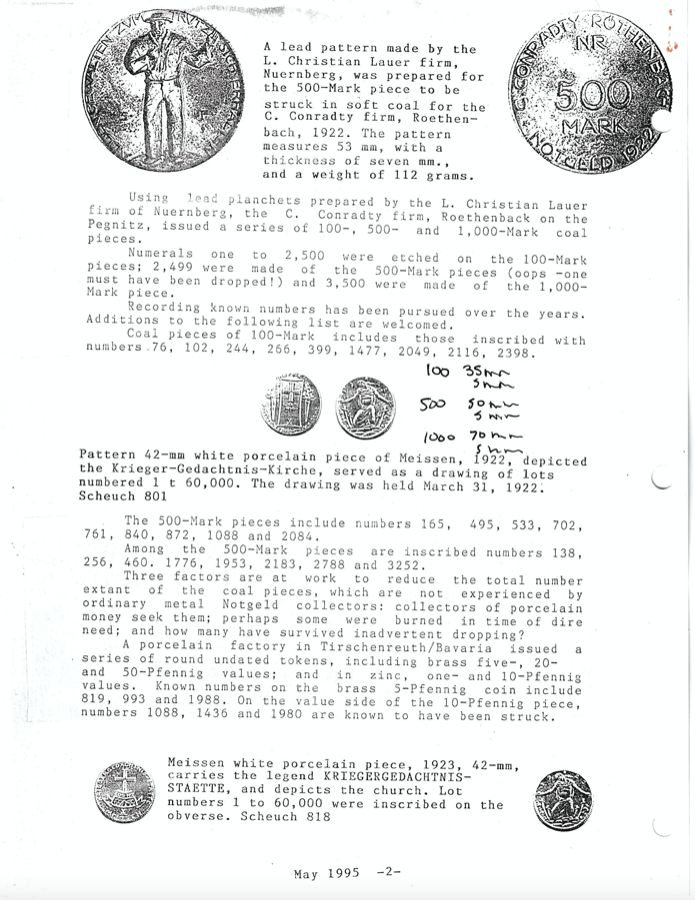
So sad to hear of Kai Lindman’s passing. He was such a prolific force in the world of Notgeld. His memory will live on through his incredible contributions and passion.
Thanks Marcel for this. It just shows how knowledgeable he was and his passing is so bad for the notgeld collecting world.
Kai Lindman (1949-2021), in memoriam.
As a tribute an article from Papiergeld # 24: a beautiful discovery of “new†Sereinscheine.
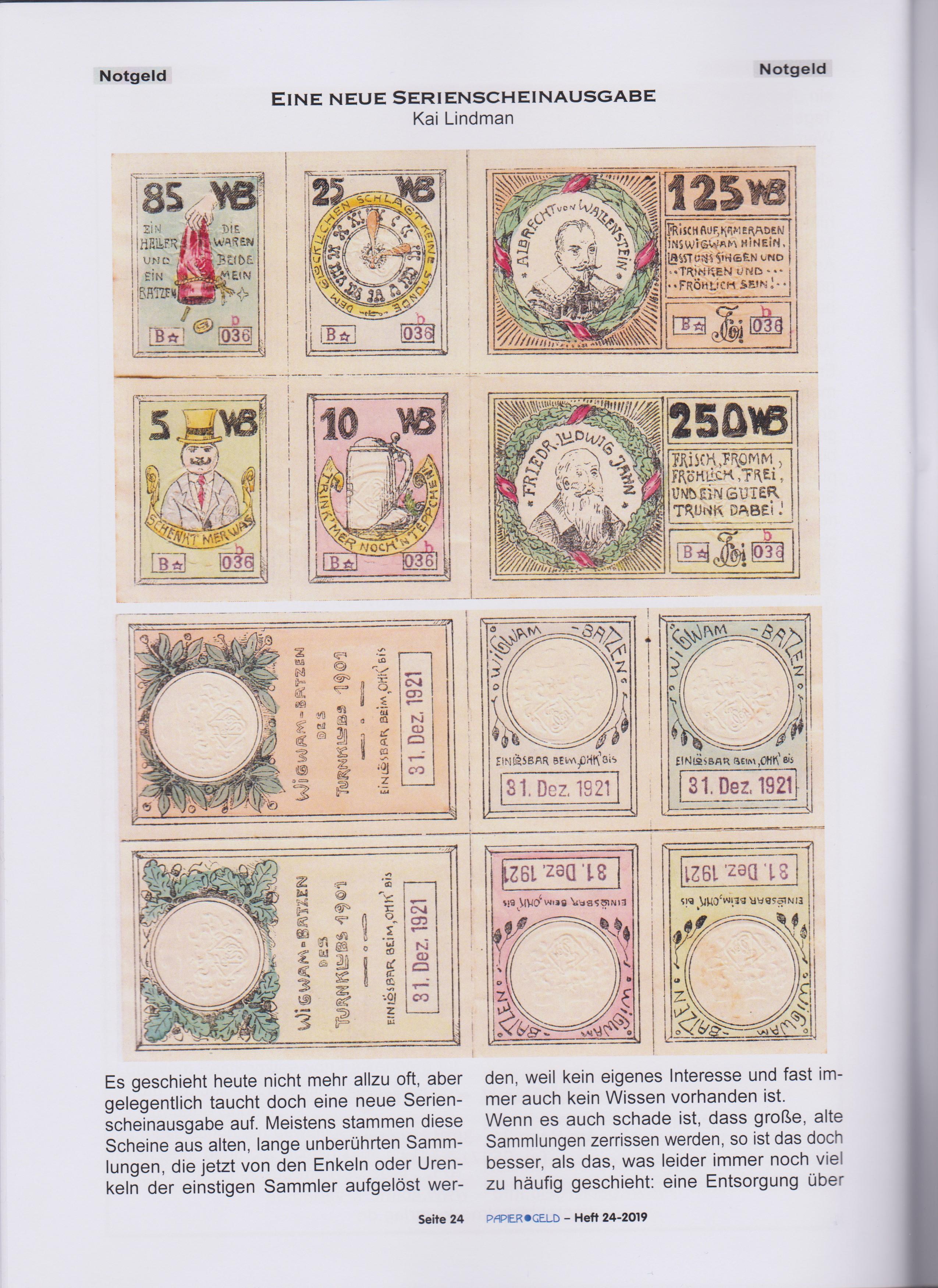
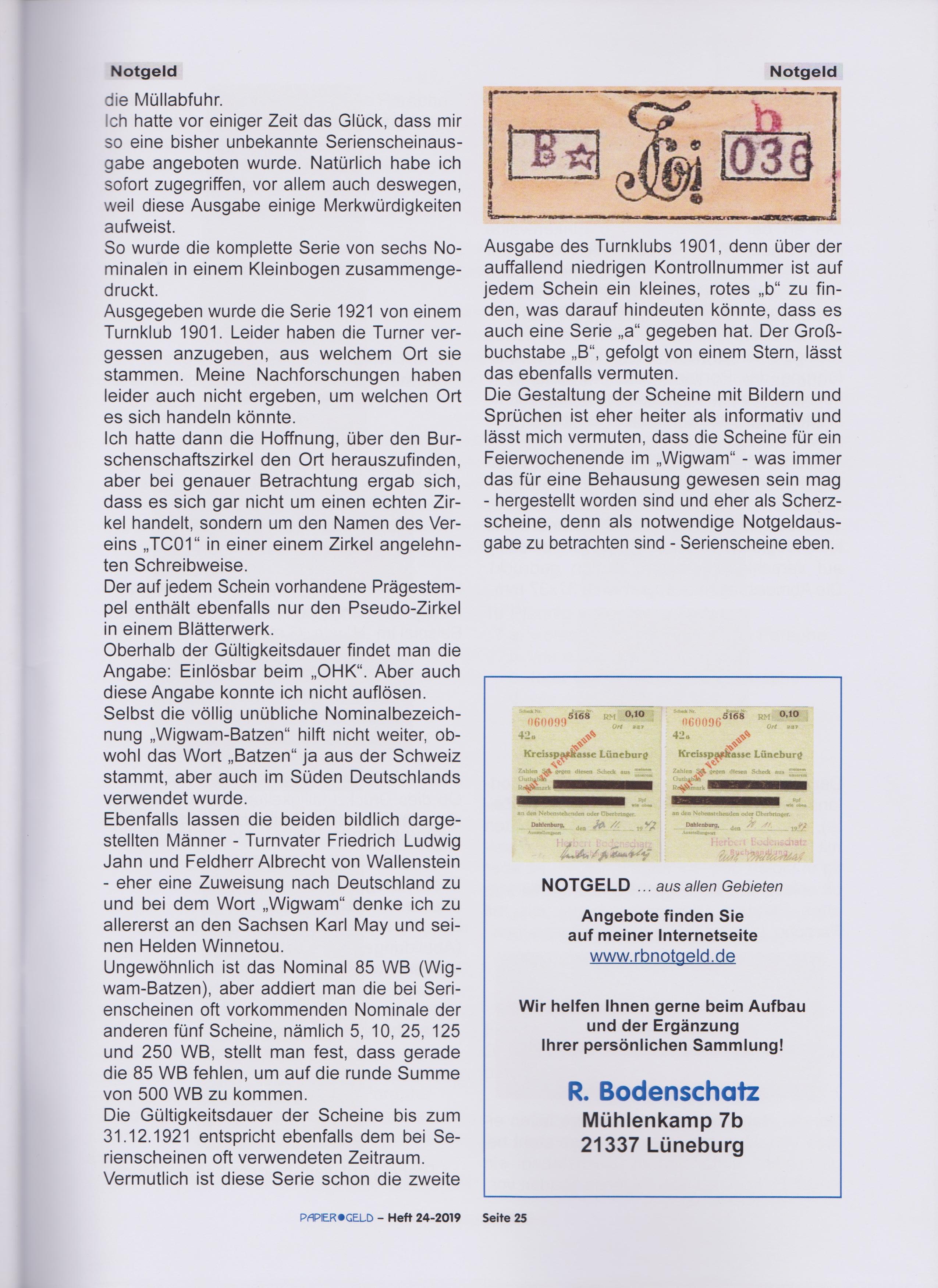
My notgeld passion continues. Today I added another scan to my Bielefeld 100m file/book. One that I have not seen over 40 years of collecting and researching them usually pops up on average once every couple of years. I know there must be others out there as all borders types probably had most different colours that appear on these types. So pieces that are ‘new’ may just be pieces I expect to turn up some day but which, so far, haven’t surfaced. What would be really good would be a totally ‘new’ piece.
Happy Collecting!

FYI – Some very sad news I want to share with you – Kai Lindman (Werner Kieselbach) has died. I learnt an awful lot about notgeld from Werner and his passing has come as a shock and has filled me with sadness. I visited him in Gifhorn, where he lived and after so many years of just chatting to him via email and telephone, I was able then to see him in person and find out what a lovely man he was. He was so knowledgeable about so many different banknote areas but to me, he will always be remembered (by me) as the ‘notgeld serienscheine world expert’!!
My thoughts are with his family and friends.
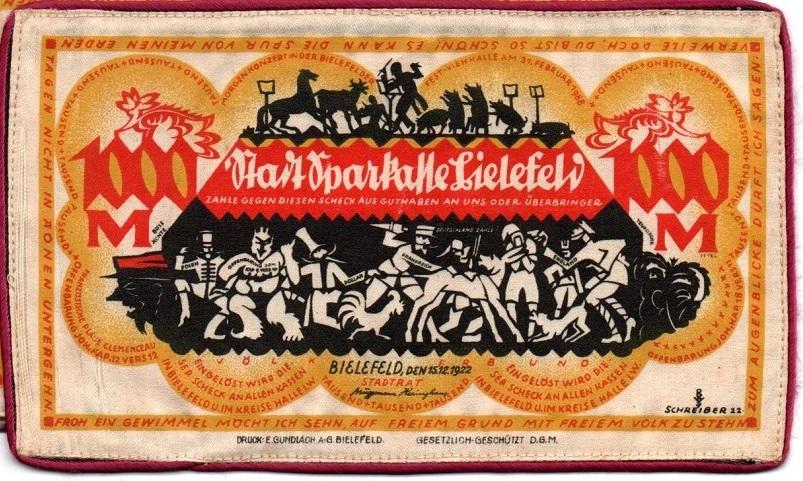
I think I still have about 8 different coloured borders here. Look at this as a great example: purple
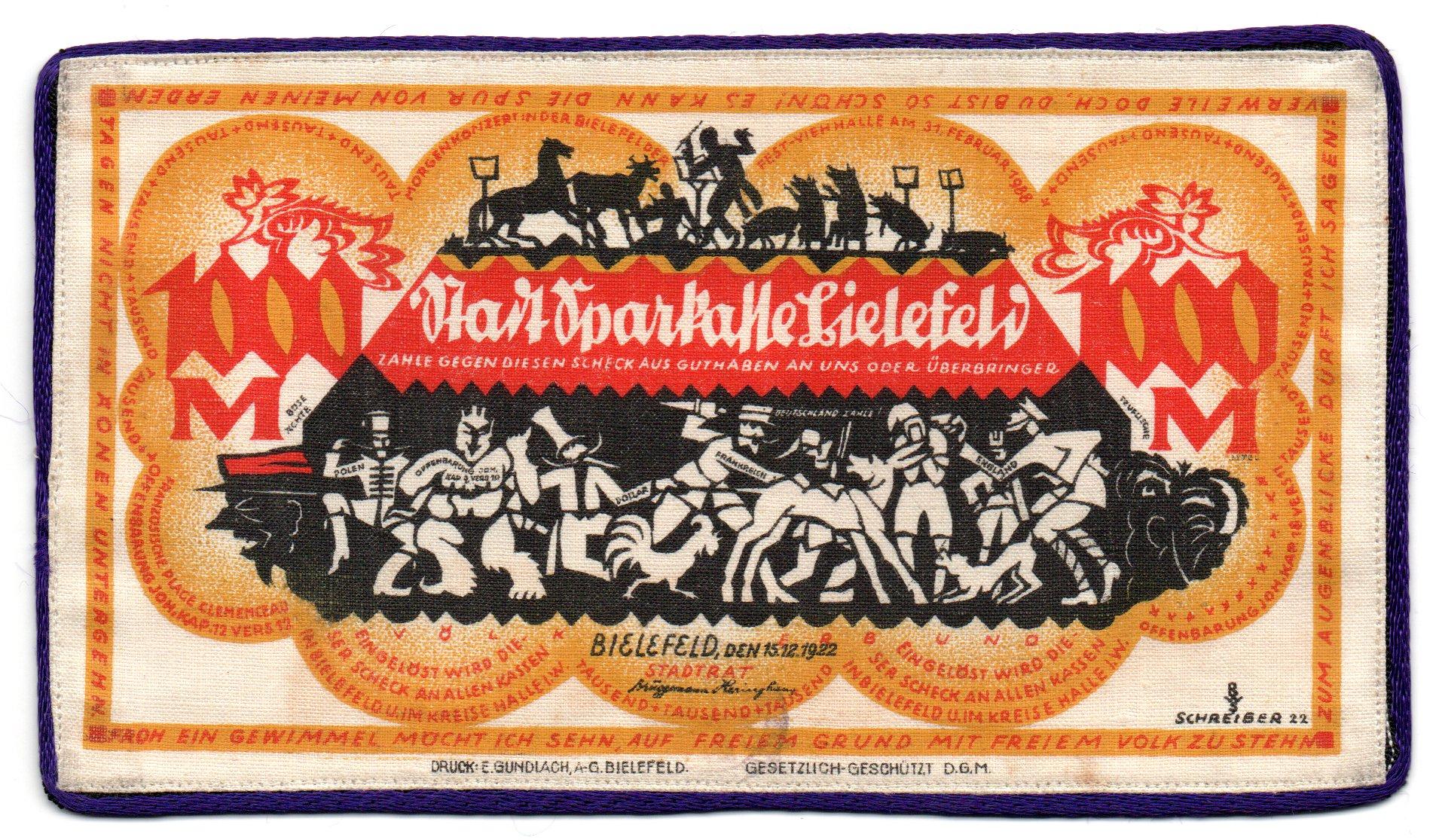
Hi everyone!
I just wanted to inform you all that I have now published a book on the LuLu site entitled ‘CHARACTERFUL GEMS‘
This book, catalogues (and explains) the different types and the different borders of the Bielefeld 1000m silk and linen pieces (yellow and green). I have managed to show 50 different pieces which are all now individually catalogued. They make for a super collection.
If you want to purchase a copy, please use the top link on my notgeld homepage section ‘My Books’. Thanks for any interest shown!
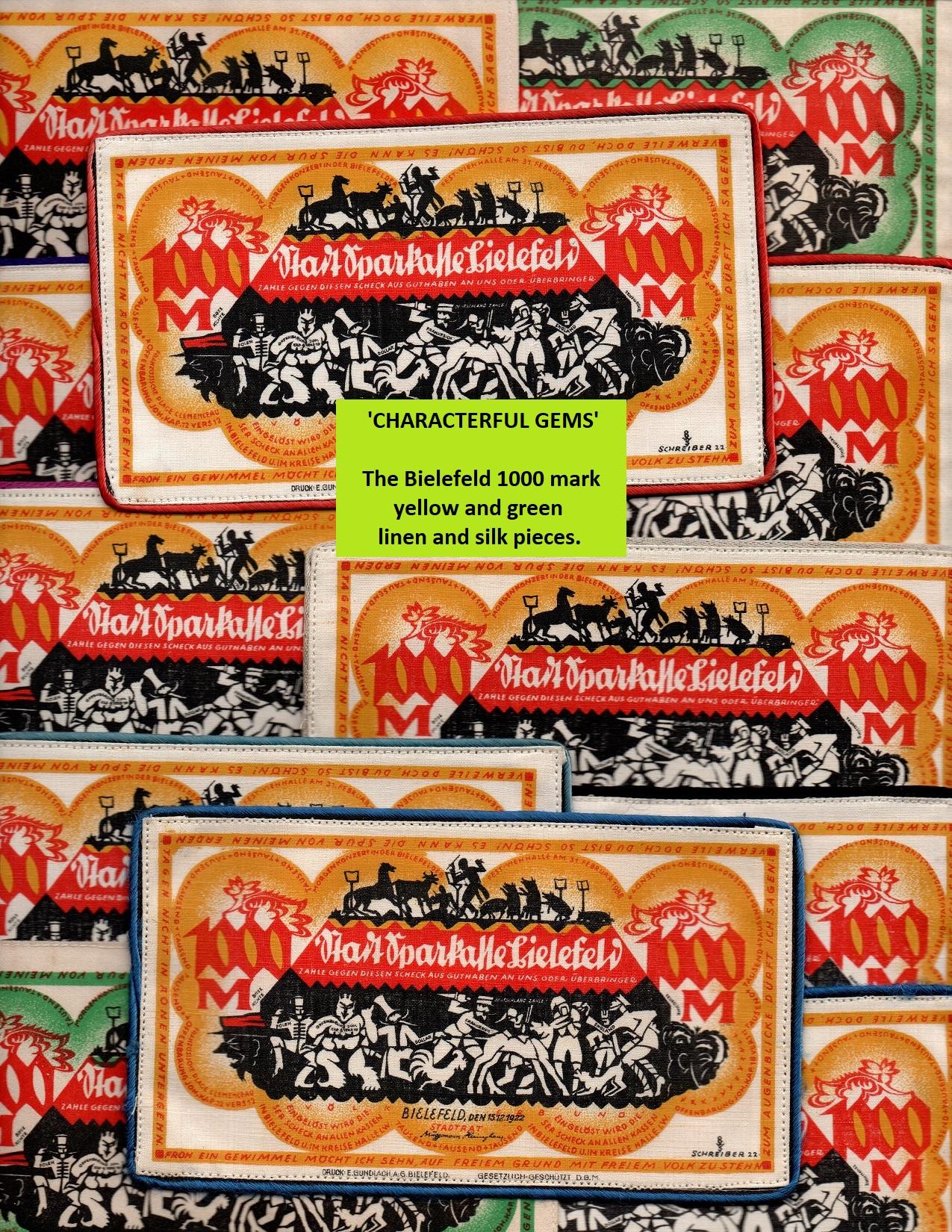
Hello all: Sorry to have been away for a while. First I took a hiatus from sorting/cataloging my collection to pursue another hobby, video games. Had a few personal things happen which also kept me away from the forum. About a week ago my wife’s children came for a visit. Children, ha! They’re both senior citizens. They left today, which is Mothers’ Day in the US.
I’m not back to working with notgeld yet, just wanted to pop on the forum to tell you I’m still alive and kicking.
Be well, everyone.
Thanks John!
I have been busy updating the ‘maps’ article with pieces suggested by Marcel.
I’ll get these ones added to the Goethe article now. There’s no rest for the wicked!!

Update on the Grossalmerode note – and its companion piece.
I’ve been doing some more digging and it seems that the issuer, the Detaillisten-Vereinigung e.V der Bezirke W.O.C.G., is in fact the Detaillistenvereinigung e.V. der Bezirke W.O.L.G.! The third letter isn’t a C for Cassel but an L for Lichtenau, as in Hessisch Lichtenau, site of one of the landmarks depicted. I’ve been corresponding with some very kind members of the Local History Club (Geschichtsverein) of Grossalmerode about the 25 Pfennig note from the same issuer, and have put together with their help the following interpretation :
On the obverse : Mercury, the god of merchants and trade, recognisable by his winged hat, his winged heels and his winged staff entwined with serpents, the caduceus, holds a manuscript proclamation of the terms of validity and the promise to pay the bearer. A young oak, symbol of a resurgent Germany, grows opposite a stalk of corn growing anew from a broken stalk, both symbolising the rise of a war-torn land.
The reverse shows cherries (for which Witzenhausen is famous), a weaver’s shuttle (for the textile factory Fröhlich & Wolff, from 1907 in Lichtenau), and the ceramic crucibles produced in Grossalmerode and which feature in the town’s coat of arms. The symbols of industry (crossed hammers in front of an iron cogwheel) may relate to the local glassworks and small-scale mining industry.
Note that the L is more obviously an L than a C on the obverse!
Hi Tony, regarding Goethe, and just off the top of my head : Serienscheine from Ilmenau, Ilsenburg, Roda, Schierke, Stützerbach, Thale, Wernigerode and Weimar; inflation notes from Neustadt im Schwarzwald and Vohwinkel. That’s 10 places and my starter for ten!
Chaps – I have just published 3 articles on ‘Goethe’, ‘Piggies’ & ‘maps’. I’m a little busy at the moment so I hope you can help me build up the listings please? I know there are lots of pieces out there but I just need to add them in. I probably have the pictures here already, so just send me the place of issue please. We will see how they go, but I thought it might be a good notgeld exercise for a few of you!
Keep well and keep collecting!!

Marcel – all sorted – thanks.
Here is a nice pair of notes I thought I would post for people to see – with and without serial numbers:
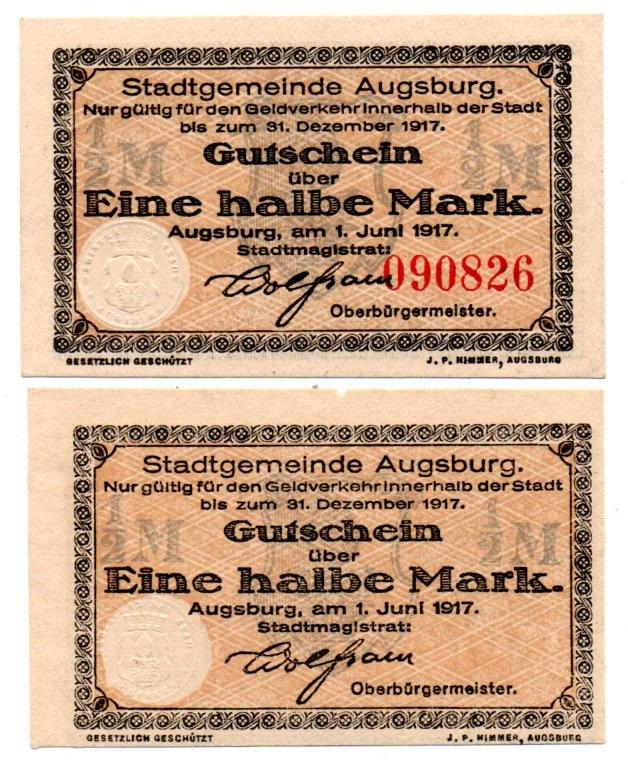
Hi Marcel – please post the other pictures again as there was some sort of error. I have left the 2 larger sized images.
700 Mark notes of Ujest and Neisse
Ujest: 27.5.1923 has two different notes. See for the examples below. The colourful note has also a serialnumber on the empty backsite.
The colourful note is used with  overprints on the empty backsite: 100.000, 500.000 and 1.000.000 Marks. They have two kinds of stamps.
Neisse: 25.5.1923 Has three different notes. Two are on “sämisch Kartonpapier†in the printing colours braun and olive. The third one is on “Büttenpapier†in printing colour olive.
These two towns issued these notes as : “Erinnerungsschein zum 700 järihrigen Jubileum der Stadt Ujest O.S.â€and “Erinnerungsschein 700 Jahr. Stadt Neisseâ€.
The translation is: both are souvenirs to the 700 years anniversary of the towns.
These two towns are in the 3ed of PUZ (Lindman “largeâ€). Are they Serienscheine?
Dr. Arnold Keller says explicit in his “Das Notgeld der Deutschen Inflation 1923â€: “Souvenir…not Notgeld†at the entrance Neisse (#3748.a). At Ujest (#5278) he says only “souvenirâ€. Grabowski/Mehl says in the preface: Serienscheine 1918 till 17 juli 1922. These two towns issued these notes almost a year later.
I think Neisse and Ujest have the benefit of the doubt. They look like Serienscheine and some of the Serienscheine in the catalogue are forgeries (e.g. Süderbrarup and Neukirch), but have found there place in the catalogues. Also there are issues after the official end date in the catalogues. And 700 Mark = 700 years is a bit of a smile to the inflation.
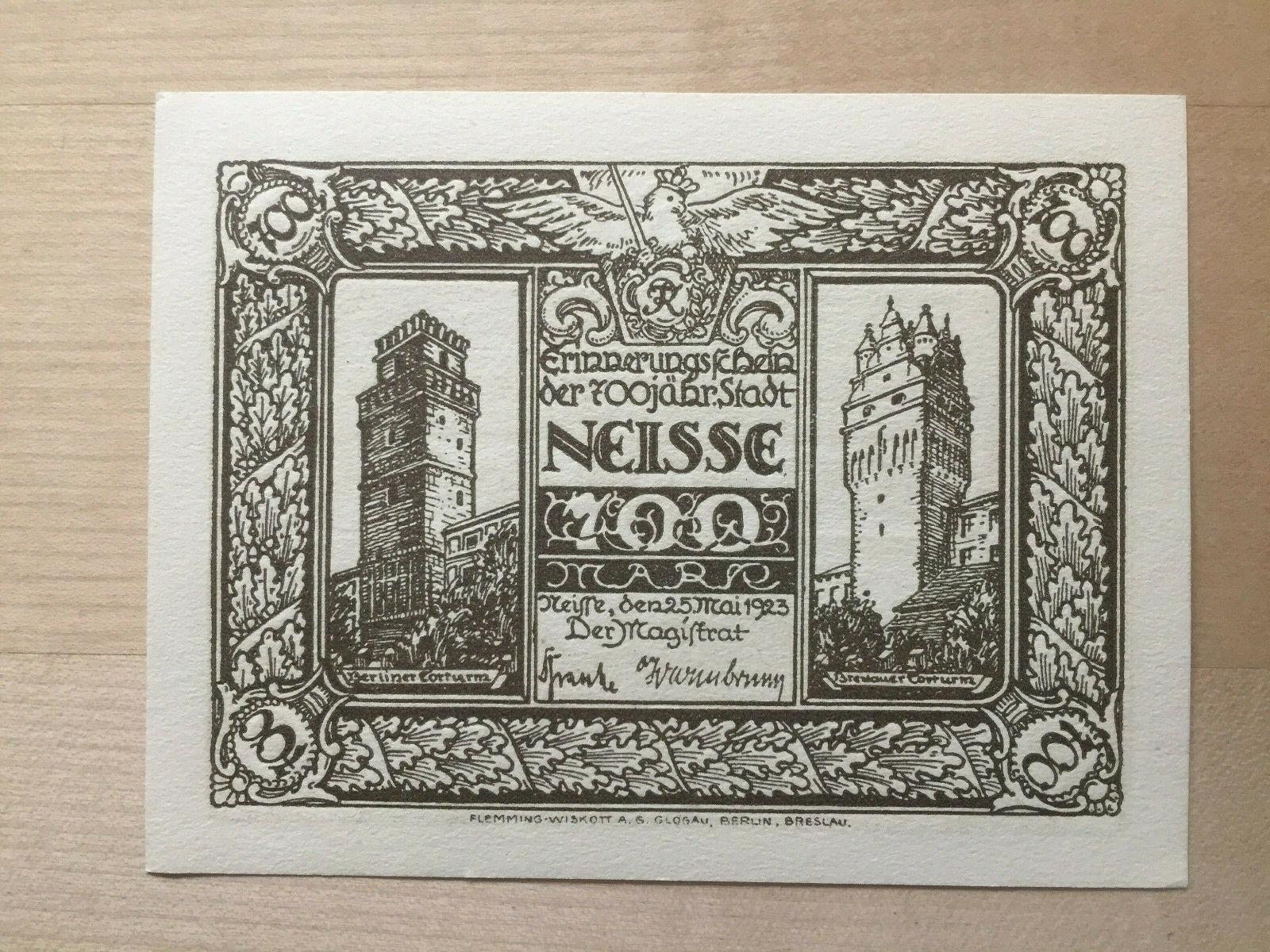
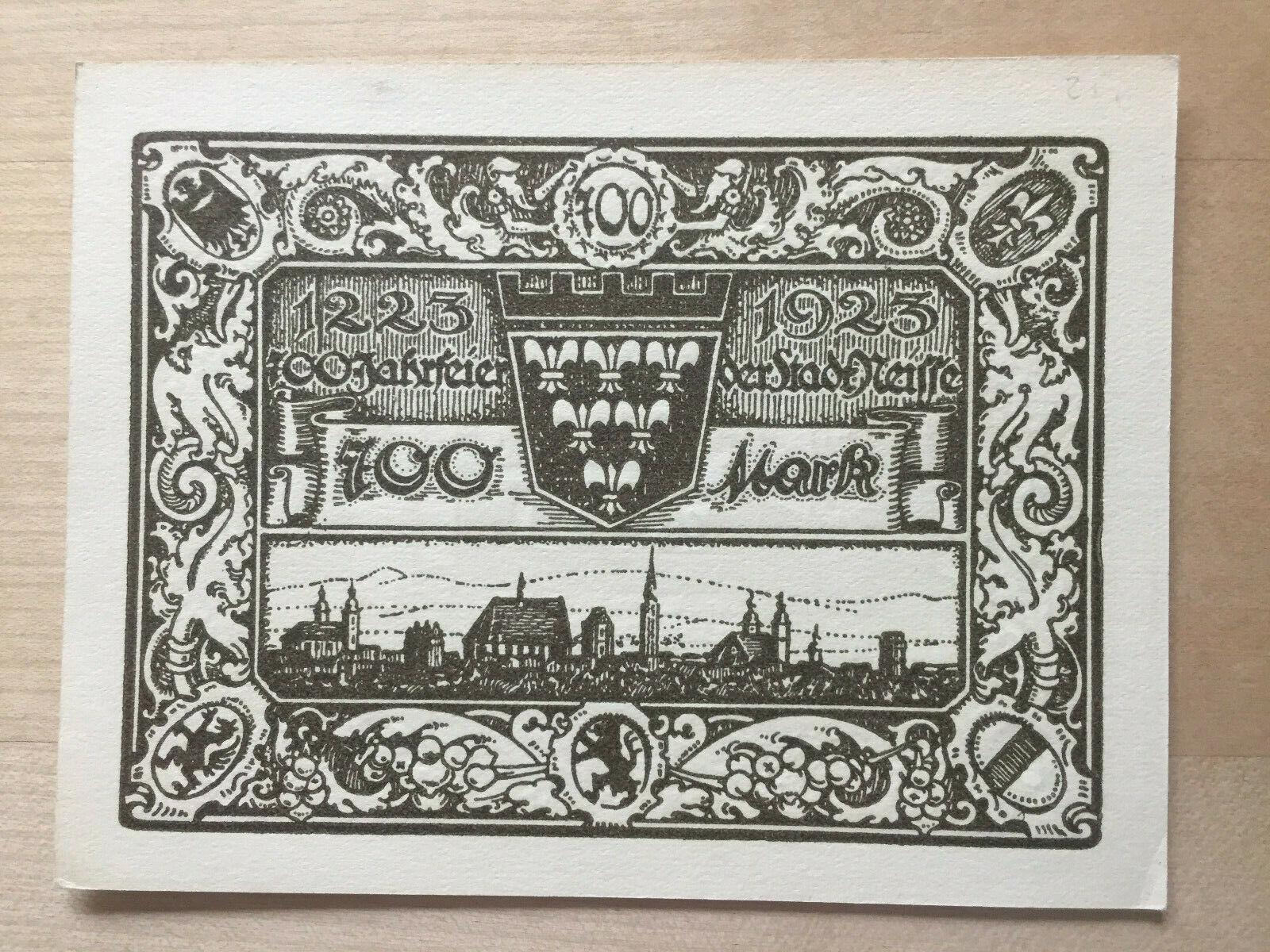
Hi John,
Yes I’ve got 1,60m note as well, that is interesting one of the 700m note
Thanks for showing me

Hi Graham, I’ve often maintained that the most useful new coin to introduce would be the 99p coin, which would save all the mountains of pennies I’ve gathered over the years and make for more honest and transparent transactions! As far as Notgeld goes, a couple of odd values spring to mind. Firstly the 700 Mark notes from Ujest (today Ujazd in Poland), which were issued to celebrate the town’s 700th anniversary; secondly, the 1,60 Mark note from the Brunswick Motor Traffic Company Ltd. (Kraftverkehrsgesellschaft m. b. H. Braunschweig), catalogued as Lindman 148a and Grabowski / Mehl 156.1. As the latter was issued by an omnibus company with the otherise normal values of 25 Pf. and 75 Pf. , I wonder whether the 1,60 Mark represents the value of a fare? The notes are also overprinted as 0,50 Mark (Lindman 148b, G/M 156.4).
I think this is the most unusual value of 99 pfennig note from Neustadt, I wondering if there is any other unusual value notes?
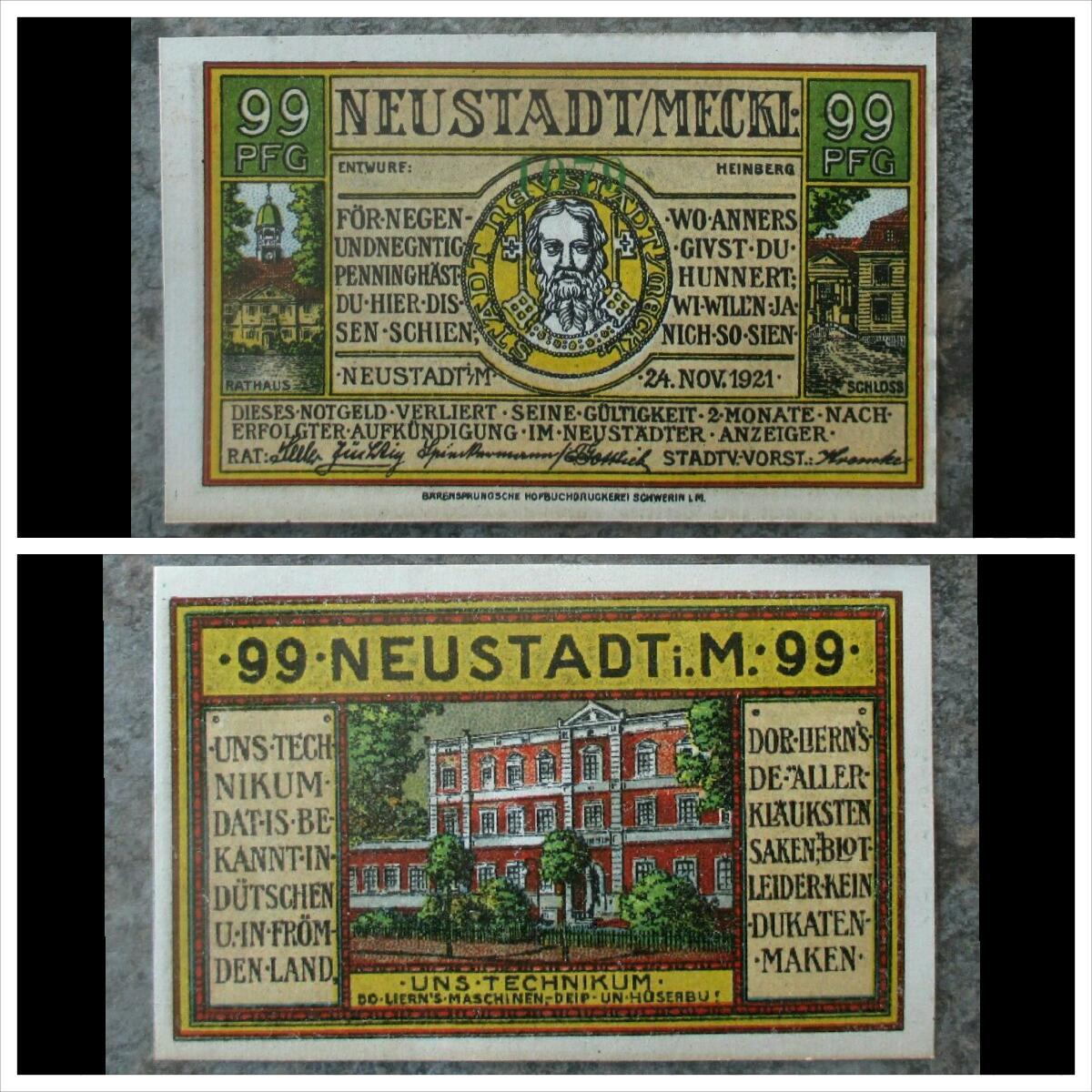
Nathaniel, It is a lot of work, but the databases I’ve seen online all seem to have duplicates or errors in them. I have also been subject to having the internet go out when I’m trying to look things up so I decided to not depend on the internet  So this is a stand alone database which will I hope encompass all of the Notgeld catalogs.
As stated the Notgelds are barcoded so that scanning the barcode will take you to the note or allow you to add a note to your collection without much typing. The database is bi-lingual German and English. There are over 31,000 notes in the database and I am in the process of making sure all the information is correct and as I see new ways of breaking data down restructuring the database.
The biggest problem is getting pictures of the notes. I have over 6,000 notes and I’m constantly looking on line for pictures I do not have. I want to have pictures for every note. That is the best way I’ve found to get the correct information about the notes.
Regards
Allan
I think the catalogue referred to for the ‘World Notgeld’Â issues of 1914 – 1947 is by Courtney L. Coffing. I think you can find it pretty cheap on eBay. From my perspective it is fairly basic, as it doesn’t list all the German variants like the ‘proper’ notgeld catalogues for each category do (I’m not just talking about Grabowski/Mehl).
Hallo Zackary,
I do not know which country you prefere, but for the Netherlands I can refer:
1. Patrick Plomp, Catalogus Nederlands papiergeld 1573-2002. This one has a big section of Dutch emergency money WWII (with pictures in color).
2. Patrick Plomp, Catalogue Papermoney of the Netherlands Part 2. Some (oversea) emergency money.
Contact: http://www.PatrickP.nl He is a very nice man, full with information!!  (NB. Both books are a beautiful overview for all the Dutch papermoney)
3. Toele and Jacobs, Het noodgeld van Nederland in de Tweede Wereldoorlog (Leiden, 1996. It is the standerd issue for emergency money WOII in the Netherlands. It is in Dutch, but a very elaborated book! (pictures in black and white)
4. See also the website het geheugen (“the memory” (of the Netherlands)); https://geheugen.delpher.nl/nl/geheugen/pages/collectie/Het+noodgeld+van+de+Tweede+Wereldoorlog
For Germany you have: Grabowski, Das Geld des Terrors, Geld und Geldersatz in deutschen Konzentrationslagern und Gettos 1933 bis 1945. It is in German. Not only the notes are discribed in the book, but it has a historical intro of of those places.
Note: be carefull with bying the German WWII money. There are many forgeries and issues of false places of issue. Is is a bit of a minefield to collect this era. For the Netherlands the prices are (very) high, because the emergency money was mostly never issued and much is destroyed (officially).
For other countries I know there are catalogues, but I do not have them.
There is a book written by ??? (forget his name) of of all the emergency money of the world (ask Tony). It is a older book, but I think which countries issued emergency money it is very helpfull.
I have just revisited my article on the ‘splittable’ issues (under category ‘serienscheine/ other’ on main yellow menu bar) and realligned pictures and made a couple of amendments. It does list quite a few but I am sure there are more…………..so please let me know when you find any not on my list!

I’ve never really been interested in these issues and don’t have any books relating to them. Guys – anyone help Zacary out here?

Thanks Zacary for your post and your comments about my new book. I hope you decide to purchase a copy.

Greetings everyone.
I am Zacary Wilson-Fetrow, a historian, lawyer and notgeld collector out of New Mexico, USA. I have been collecting notgeld for many years now (at least four). The first notgeld I ever bought was the Bonn Beethoven notgeld coin, before I got into the notes, where I now focus.
Tony asked me to post here to talk about some of my recent history work. I had an article published by the The Numismatist that discussed the history of the Reutergeld notgeld from Mecklenburg. In it, I investigated the life and influence of Fritz Reuter, discussed the historical context that led to the Reutergeld, and explored the major design elements put into the 210-note Serienscheine. I am also happy because more facts about the notes’ designers were finally uncovered in historical records not long before the article was published. I was able to get in those details.
I had a lot of fun writing the article, and I have shared a copy of the first page below. You would have to become a member of the American Numismatic Association to see the rest, but I am happy to answer questions.
Other than that, I have a few other writing projects in the works. When I wrote the Reutergeld article (back in late 2019, it took over a year to publish), I had a lot planned but also a lot on my plate. Now I have more time, and I am planning on an article for The Asylum of the Numismatic Bibliomania Society about the main book I used for my Reutergeld research. I also have articles I have been researching for two years about Esperanto, Greenlandic, and Culion Island (Philippines) currency.
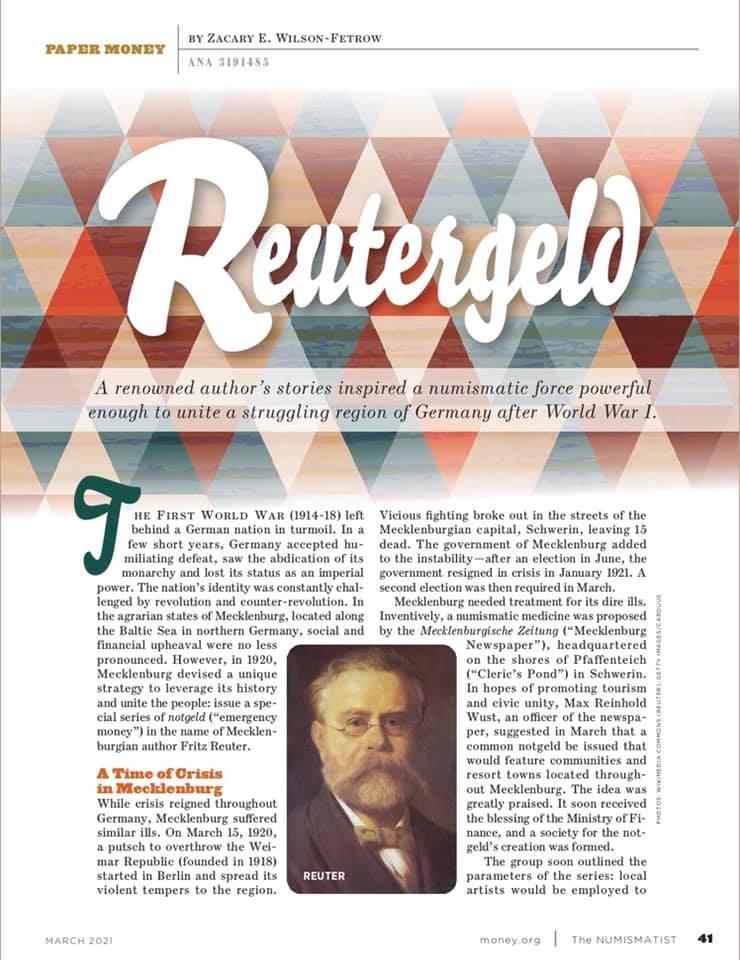
I really like the idea of this book. Nothing is sadder than reading about an exciting notgeld, only for it to be picture-less.
I would really like to look into the WWII era notgeld. I adore the traditional era, but I do have a closer connection to WWII history. Is there a best source of information on the 40s issues?
I am excited to see the “splittable” notgeld section. I haven’t wandered the website in a while. They’re my favorite type of notgeld, and I hope to make an exhibit of a few types for the Albuquerque Coin Club once the pandemic is over and we have our state fair again.
Thanks again for the thoughtful response and feedback, Marcel! I agree, it is ALWAYS easier to SEE the variations instead of read their descriptions and try to imagine what it looks like. This is the main thing I want to improve in my catalogue vs. the existing catalogues. I want to have images for every note possible, including the varieties. This will mean a much bigger effort, but I think it will be well worth it.
Good idea on including the Lindman numbers as well. I will figure out a good way to incorporate those numbers on the relevant listings.
I’m not sure I’m familiar with the “PUZ” catalogue you mentioned. Could you provide a link or photo so I can see what this catalogue looks like? Thank you!
Hallo Nathaniel,
Thanks for your nice words. Yes, that is what meant. I had German lessons on school and went reguraly on holiday to Germany, but it is sometimes hard to understand German, especially the specific e.g. technical words or the names for tools, animals, plants or art. Dutch resembles German. My mother spoke whole conversations in only Dutch with German people and they understand it (I hope!!).
A tip: add the Lindmannumber also in your catalogue. I think the best recognition is the picture of the note (front and back). That makes the Grabowski catalogue easier to work with than the Lindman. I personally work with the PUZ catalogue (if you are collecting, collect them all!!). The base is Lindman, but is elaborated in the details (e.g signatures (Friedeberg am Queis), dry stamps (Potsdam) and has also an overview of the enveloppes/folders and the overprints and if there are printsheets.
It is a great effort yo make a good catalogue. It is not easy to tell in words what are the specifics ans the differents. After more than 25 years of collecting I am not sure what the catalogue sometimes means with e.g. Altona Landesbürgerrat: Rs black and RS blue. Mostly you see the difference when you have them in your hands and good daylight (!), e.g Aschersleben with the print “SPAR”. When you have a lot on your desk finally you see what the catalogues says. Or paper: white and greywhite. Or Lichtenstein: three catalogues tell a different story.
Overall: with the years you learn more. That is why I love this Forum.
My new book ‘ELUSIVE GEMS‘ is now available to purchase. It covers the main catalogue entries in the 2 blue Grabowski/Mehl books that have no picture! Most of these pieces are very rare …….and elusive, which is why they didn’t appear in those 2003 catalogues. There has been 1 update since which added a few but I can’t be the only collector still using the blue serienscheine catalogues, surely? I drafted up a list of over 100 entries with no picture and then tried to find what those pieces looked like. A fascinating project and a lot of learning along the way. I do hope you purchase a copy and enjoy all the pictures and info supplied within it.

Marcel – perhaps this is what you meant by including the English + German names? (The lefthand page)
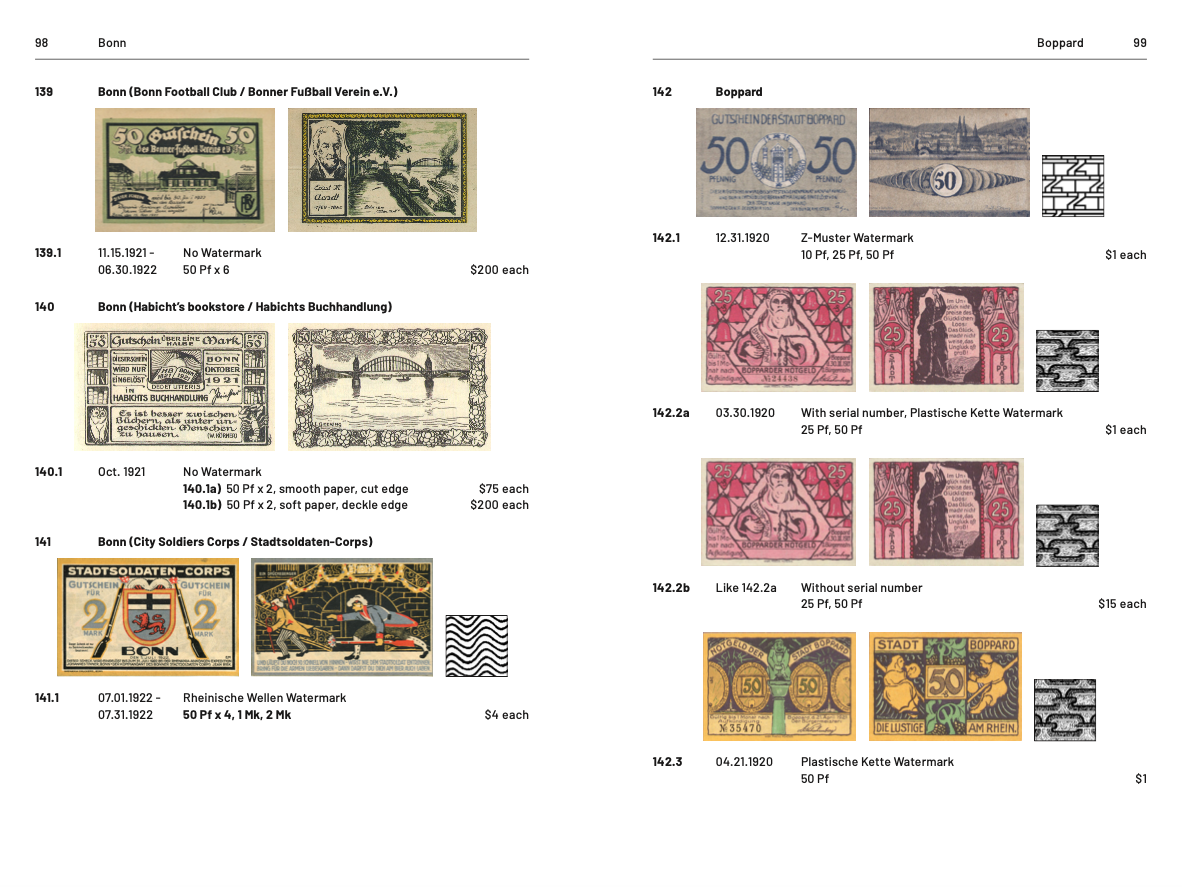
Marcel – thank you for all these wonderful suggestions! Some will be much easier to integrate than others, but they are all really great ideas. I definitely want to do zoom-in images of certain details so its easier for the reader to identify specific varieties. Being more descriptive about which side of the note features something like the printer’s name is a great suggestion, and easy to implement. I’ve found that standardizing the scale of the images can be REALLY tricky when fitting everything into a page layout. Maybe if I include millimeter measurements of each note it would help?
Question: When you mention including the German name of each note, what exactly are you referring to? Could you give me an example of an English name vs. German name to help me understand?
For storage of images, yes, cloud storage is definitely the easiest way to do it. Dropbox is a good inexpensive option, and is what I use, but there are many other options to choose from.
Hallo Nathaniel,
What a beautiful catalogue you are creating!! Is is a lifetime achiefment.
I have an electronic catalogue. It is a combination of Lindman and Grabowski. It has 23 (!!) entrances e.g. number Lindman, Grabowski, own number, city, issue point, discription of the note (text or image etc), the value, in possession (0 or 1 or2…), Type I or II, with or without KN or No etc), watermark, artist or designer……………….  But, the catalogue is in Exel and to big for my screen, so you have to scroll left, right. And the other problem is you have to discribe EVERY note. I have till now about more than 32.000 entrances. Not all existing notes, but for the overview it is better so.
Further, I would like a picture of every note (front and reverse). Now I have to look in my albums. The problem is: how do I do it? I have more than 12.000 notes, so I need to scan everyone RS and VS. To intergrate them in the electronic is too heavy (in bites) or do I store them in the cloud?!
So I use my paper catalogue when I have to look up something or when I am on a fair. (and I have on almost every page made notes, because the catalogue is not always clear enough or the note I have is not perfect enough, I underline it or I have a special note in a serie etc.) I use the electronic catalogue as a back-up and for the statistics (value and quantity) or when I am on holiday in Germany to sort out the places in the neighbourhood.
A question for you Nathaniel: How do you registrate the notes you have (I see e.g. Aken 4x 75 Pf; which one you have?). I like the picture of the watermark next to the note. A tip is to say where the printing company is(front or back). For the pictures: try to make a standard size e.g. 50 %. May be it is useful to add the German names of the notes. You can identify them better when you are at a fair (they are not always stored on alphabet). Is it possible to zoom in on the notes for details.
Good luck.
Hi Randolph, and welcome to you! I myself actually started collecting a good number of years ago with notes of the Hyperinflation that would turn up on bric-a-brac stands in Germany, and although my interests have widened considerably since, I still enjoy inflation notes and have about 400 of them from 1922-1923 as a sub-section of the collection. I usually look for a note with a peculiarity or an interesting story or background.
Here’s a sample, an unusual 1,000,000 Mark note issued by the Hordeaux-Bergmann Aktien-Ges. für Korbwaren-u. Kinderwagen-Industrie and Hordeaux-Bing G.m.b.H. and printed on paper taken from or intended for a catalogue for basketware, one of their products (see reverse side of note).
I was a little puzzled that there were signatories for two firms, so I did a bit of research and found out the following nuggets : in 1890 the Frenchman Amédée Hourdeaux turned his firm into the AG für Korbwarenindustrie vormals Amédée Hourdeaux with the assistance of the Bank of Thuringia in Meiningen and some Dresden bankers, the Arnhold Brothers.  In 1908 the company acquired the Kinderwagen- und Holzwarenfabrik GmbH in Wasungen and in 1909 merged with its competitor Bergman & Co. in Hirschaid and Lichtenfels. The company produced perambulators; dolls’ prams; bassinets; wooden products such as children’s chairs, doll’s sports cars, sledges; basketware; and, woven and upholstered furniture. They formed a syndicate with the Bing-Werke AG in Nuremberg in 1921, hence the note being signed on behalf of both company and syndicate. Eventually the syndicate merged and the resulting company survived until 1978.
Happy collecting! May you always find the pieces you’re looking for and the ones you didn’t know you were looking for!
Hi Allan! That sounds like a very cool project! I had started to put an online wiki together just for my own reference (in English) to more easily look up new notgeld notes that I acquired. It’s a ton of work, but it has been very helpful. When might we be able to get access to your database? I’m excited! :D
Another personal project I’ve been working on is the idea of putting together a new notgeld book in English. It would build off the of the Grabowski/Mehl Serienscheine books, but hopefully include a lot more photos and potentially more varieties (from Lindman’s work). Here is a link to a 20 page sample of what I’ve been developing. Any and all feedback from anyone on here would be extremely helpful! What sort of information do you wish you could find more easily in a notgeld book? In what ways do the current catalogues fall short? Thank you!
Hi Randolph! Welcome and thanks for your first forum post.

Welcome, Randolph!
John – that is an amazing story! Haha. Thank you for sharing, as always.
One thing I did not mention in the previous post is that I have all the notes barcoded to the catalogs so if you wanted to add the note to the collection side if the database all you would have to do is scan the barcode then add the details particular to that note (Kontrollnummer, cost, etc.)
Hi The introduction section seems to have been taken down so I’ll use this one since what I’m doing pertains to this section. My name is Allan Jacobus, been a member for little over 3 years and have a lot to thank Tony For.
I have been working on a project to create a database of the Notgeld catalogs (Serienscheine Bands 1 & 2 and Kleingeldscheine Bands 5 & 6) in both German and English. When I first started I was lost (until I found Tony), information online was confusing. I had found and bought a database that Kyle Mathers had written but sorry Kyle did not work for me (Even though you did do a lot of work to get my banknotes imported to your database). S0 I decided to write my own since most on line databases had some mislabeled notes and even the catalogs had a lot of errors in them. As I said before it is in both German and English and I hope to have (big dream) all the pictures of each banknote. I have both of the Serienscheine books done and 50% of the Kleingeldscheine books done. Work has been slowed down lately due to to some outside problems but I hope to have it done pretty soon.
I will let people know when it is finished.
Now for some fun, if this entry seems to be long, blame it on Tony who suggested I let everybody know what I was working on.
Hello Everyone,
I am a new member of notgeld.com, and am a fairly new collector in general too. I am particularly interested in inflation bank notes and have a growing collection. I look forward to learning more and interacting with you guys on the forum.
If anyone else is interested in inflation notes, please let me know and maybe we can start up a separate thread.
Speak soon!
Randolph.
Fascinating info.
All forum readers – latest article about the artist Georg Koetschau is now live and showing on the ‘latest articles’ section.
Have great Easter!!

One of my Notgeld interests is the coats of arms of towns and states and individuals, and the stories and histories which lie behind them. A couple of years ago I was lucky enough to be exploring Quedlinburg in Saxony, a gorgeous old town from which I have a number of Notgeld pieces. The example below is Grabowski, Q1.3b.1, from 10th May 1917.
If you look really hard you can see a little dog in the middle of the coat of arms! I thought I’d find out why.
Quedlinburg’s emblem, as shown, is an imperial eagle (Quedlinburg was a Reichsstadt, an Imperial Free Town) upon which is a shield bearing a castle (Burg) containing a dog. One legend says that a dog called Quedel once barked to warn the citizens of an impending attack by a band of robbers, hence the name of the town: “Quedel + in + Burg† (“Quedel in castleâ€).
In another, more involved origin legend, Kaiser Henry III fell in love with his own daughter Mathilda, who wished she was ugly so as to quell his passion. She even made a pact with the Devil who agreed to help her, but he would take her soul if he could catch her asleep over the course of three nights. Â Quedel the dog helped keep his mistress awake to cheat the Devil, who clawed her face in rage, and thereby kept the pact. She founded an abbey called Quedlinburg in commemoration of, or in thanks for her handy canine-assisted Satanic incest-preventing disfigurement (?!). Why she dealt with the Devil rather than praying for divine intervention is perhaps another issue …
[NB Quedlinburg Abbey was actually established by St Mathilda, the wife of Kaiser Henry I, a good century before Kaiser Henry III, who did have a daughter called Mathilda, later Duchess of Swabia, of whom history records no funny business with Satanic pacts during an apparently blameless life.]
Legends are of course notoriously unreliable, but the two attempted explanations of the presence of the little dog on the note are at least diverting.Â
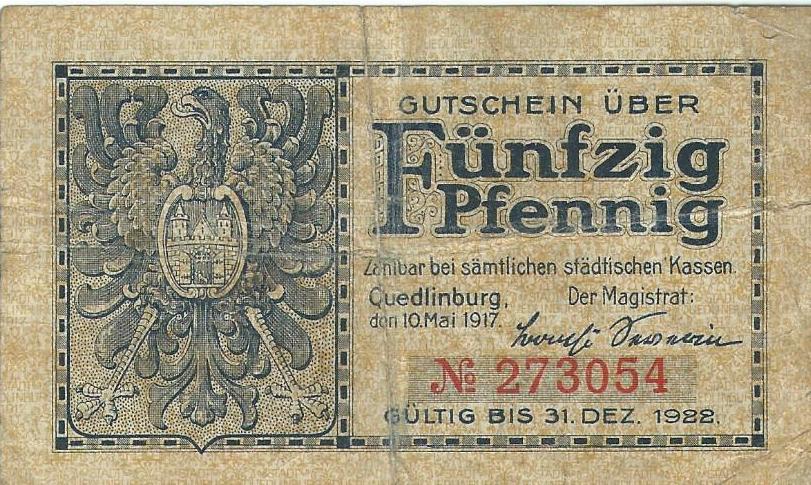
Yes, I think you are right Marcel. I wonder if it had anything to do with the 1947 notgeld issues – possibly a piece they re-used. I have never taken much interest in the later issues but I have seen a couple.
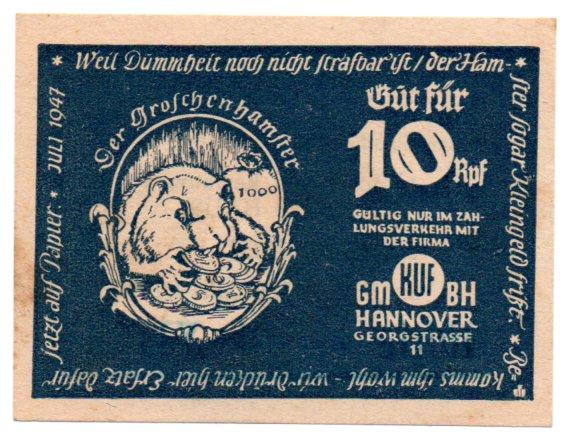
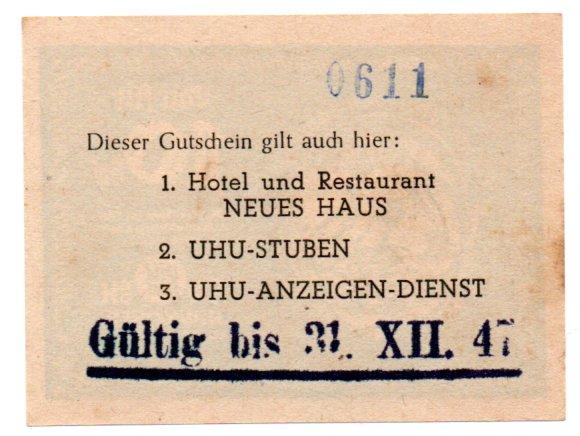
Have you tried to find a notgeld with your birthday as the date of issue…..not the year though. I thought it was a nice little exercise and was very pleased when I found a couple of variant notes. I’m thinking of framing them and hanging them in my ‘notgeld room’!! Anyone else done the same thing?

This is all wonderful info gents, so thanks for all the posts. Keep ’em coming!!
I stumbled upon this note recently. I hope you like it and find it interesting…….
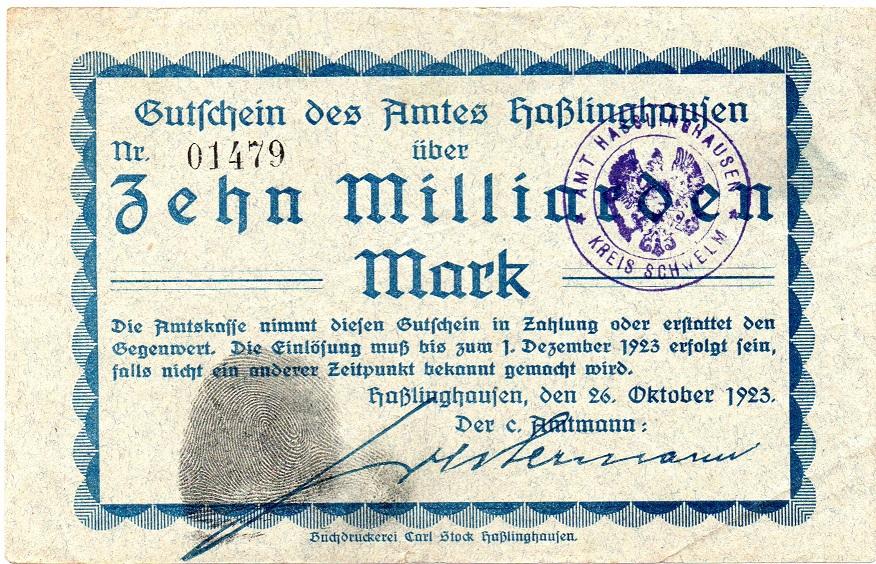
Its the first example I had with a fingerprint ‘signature/stamp mark’.
Who can identify the date stamp on the 50 Pf #3 note of Gatersleben? I think the date is: “1947 sep. 3”. I am not sure of the last figure.
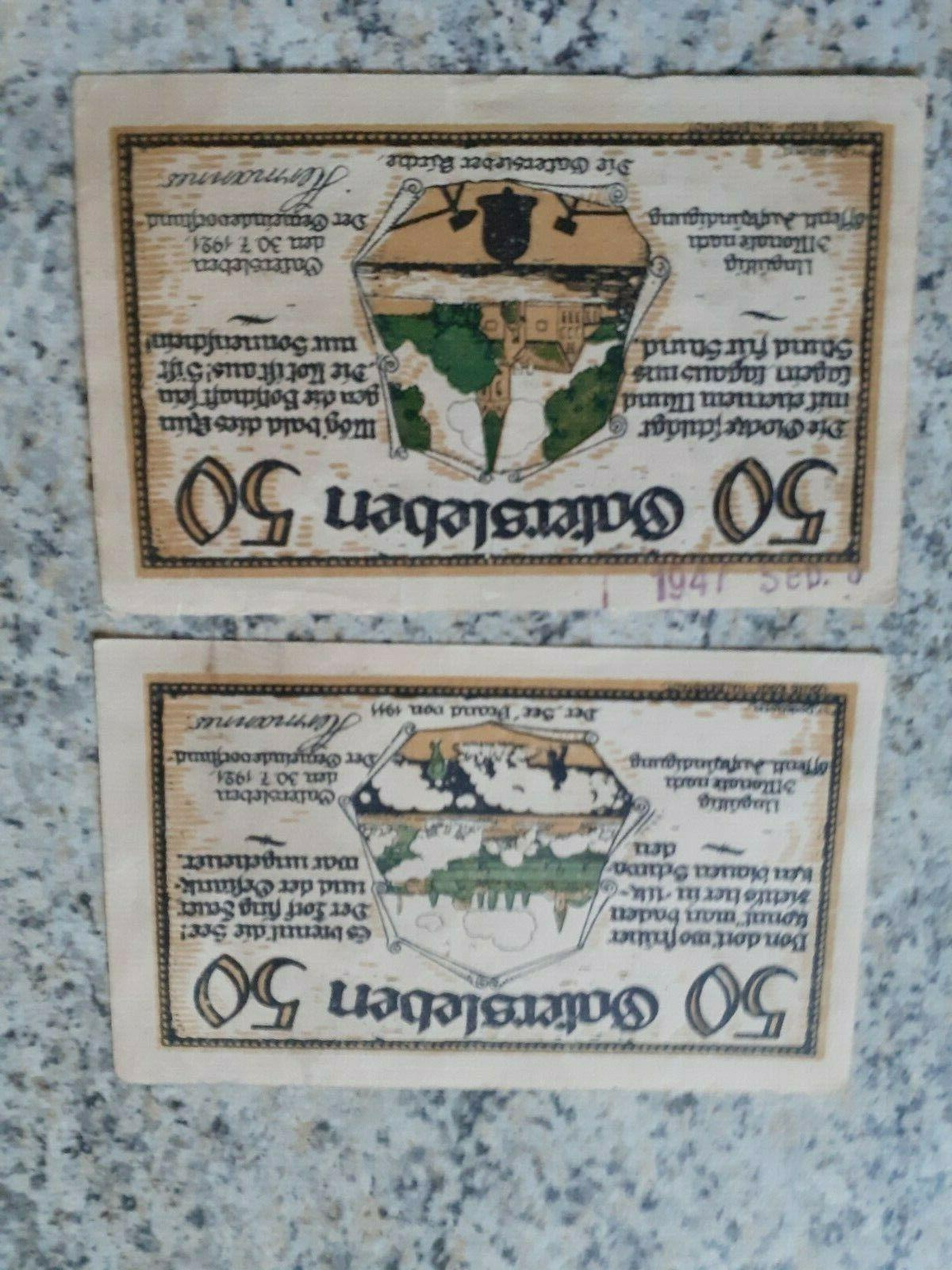
Stargard, Sammellager für Ausländer (“Assembly camp for foreignersâ€)
Just after WWI there was a great migration in the east of former Germany. Â Soldiers who want to go home, but also civilians. The new state of Poland was at war with Russia and they forced them to fight in the army against the Russians. Much of these refugees where Jews, because of the many pogroms. The most of them migrated to the USA.
To make it easier to concentrate this migration, the German state established assembly camps in e.g. Stargard and Cottbus-Sielow.
Stargard issued Notgeld for this camp. It was only valid in the camp. With a stamp the note was made invalid.
The camp was closed end 1923.
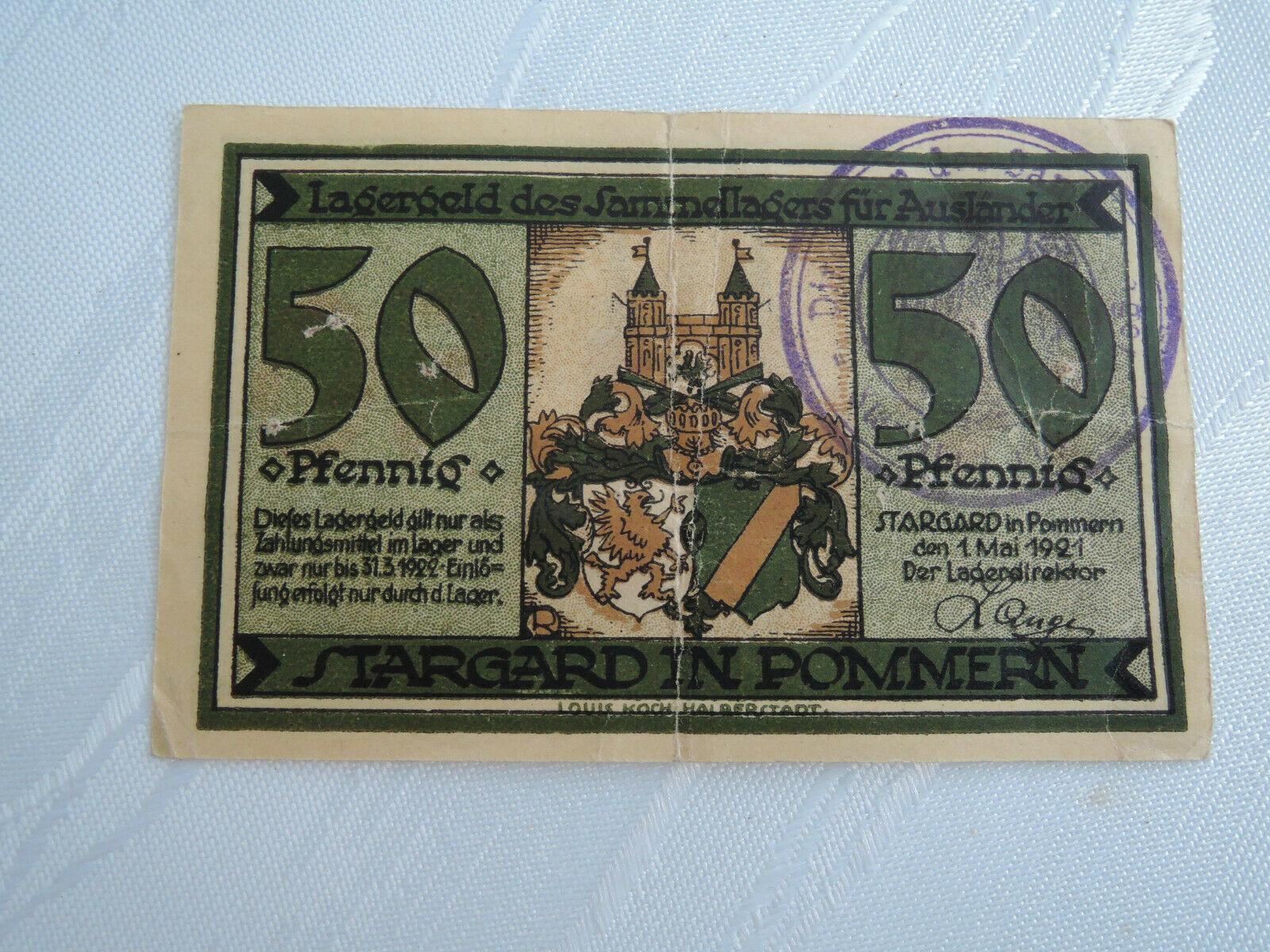
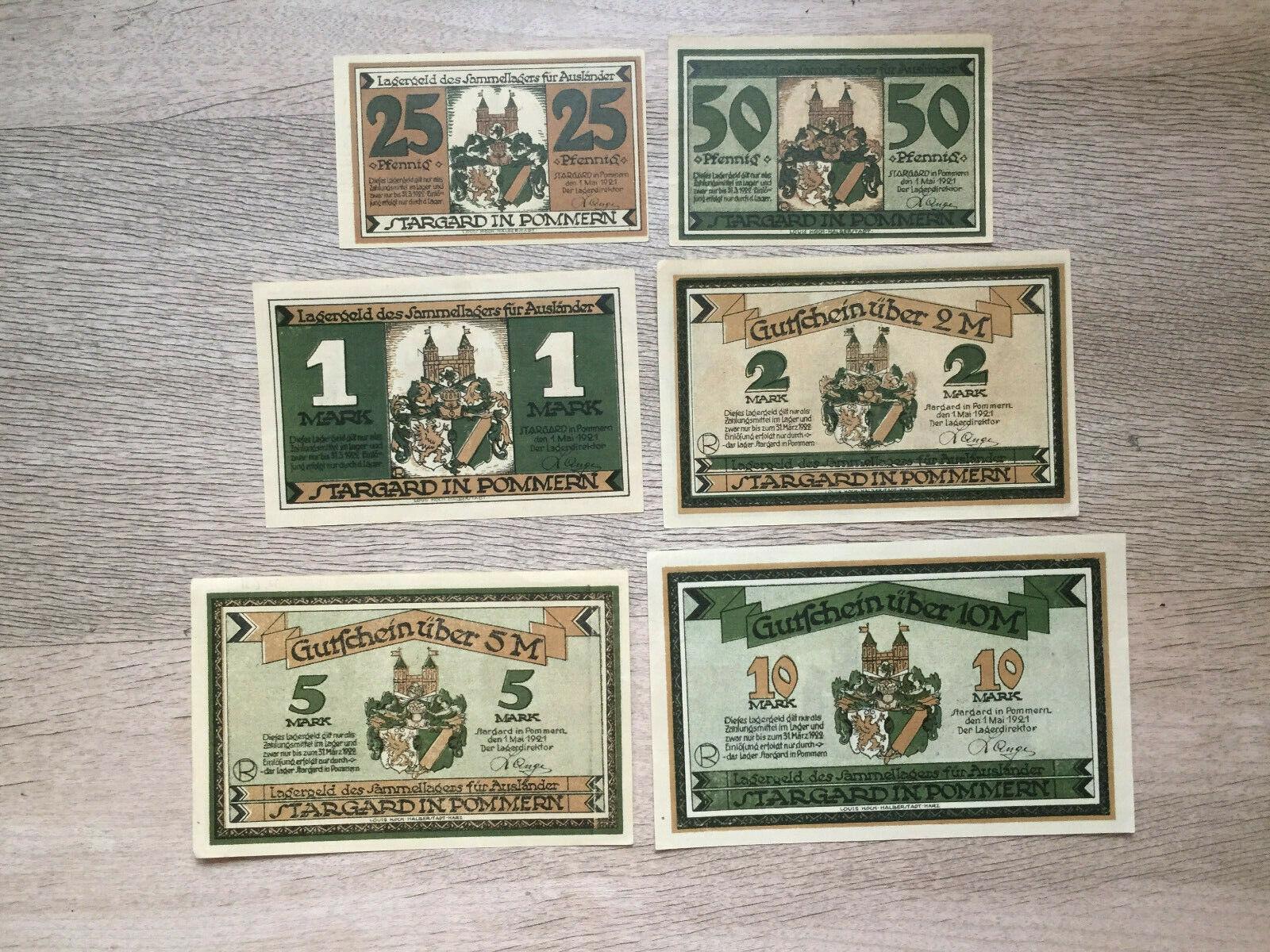
-
AuthorPosts
